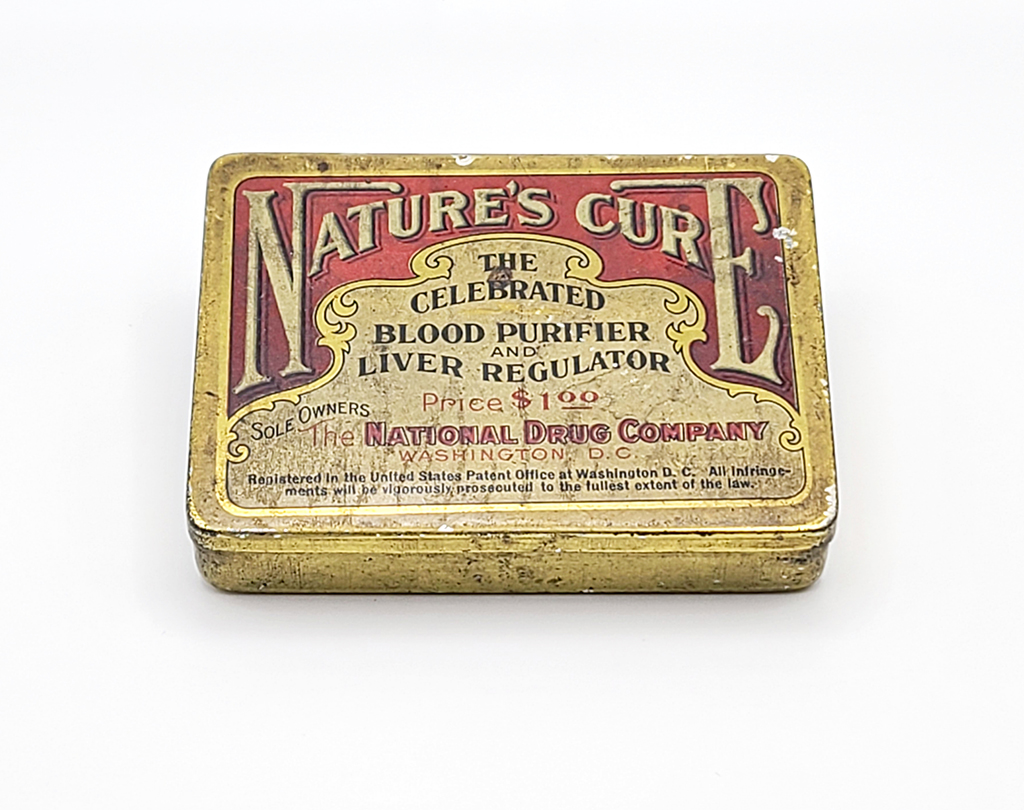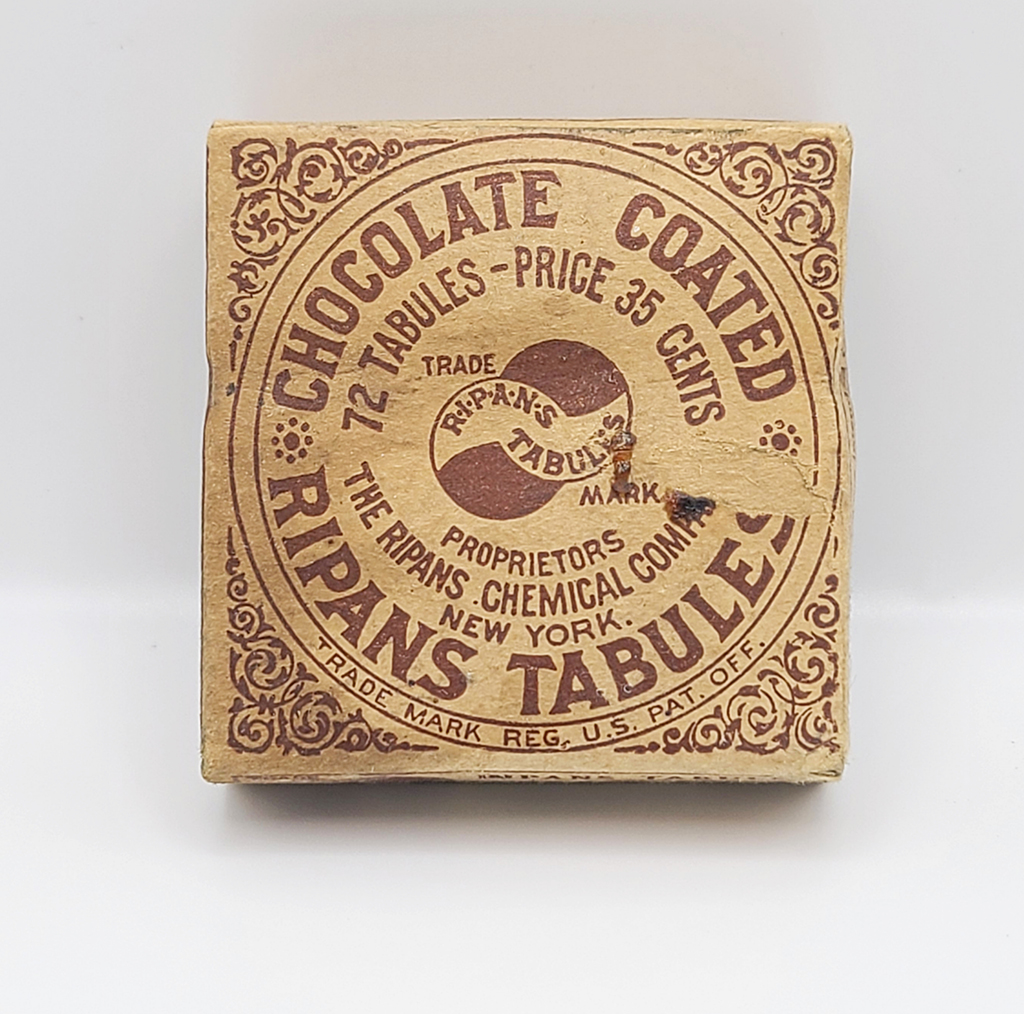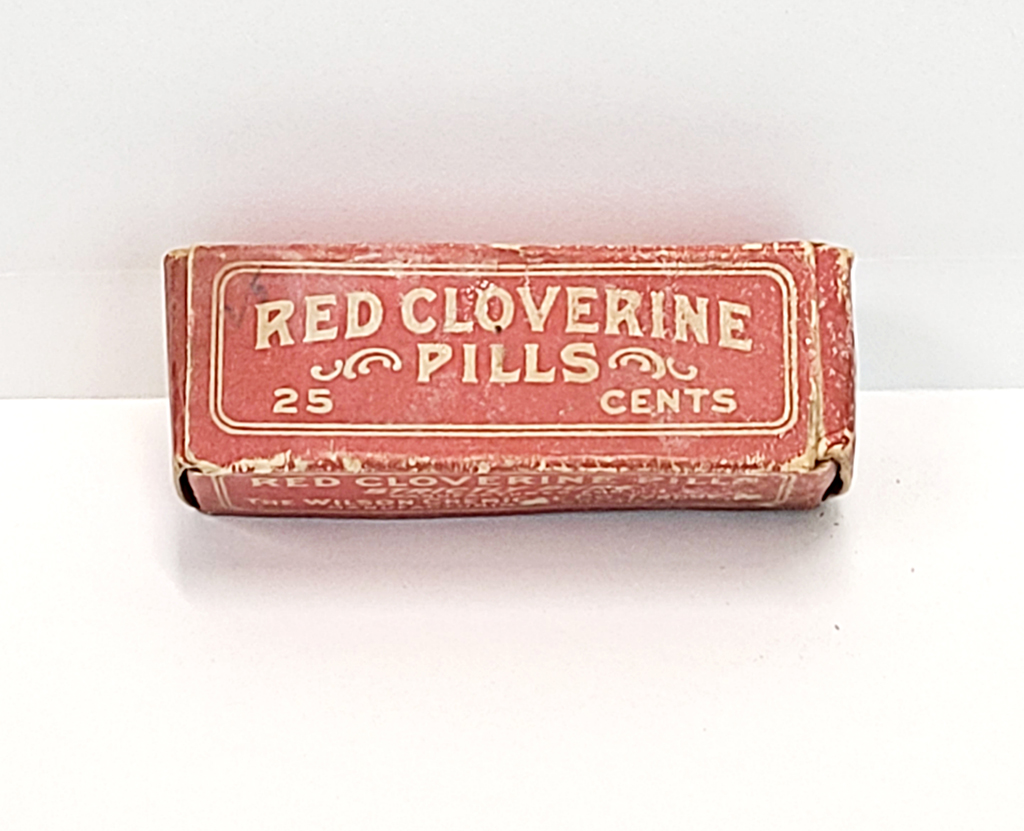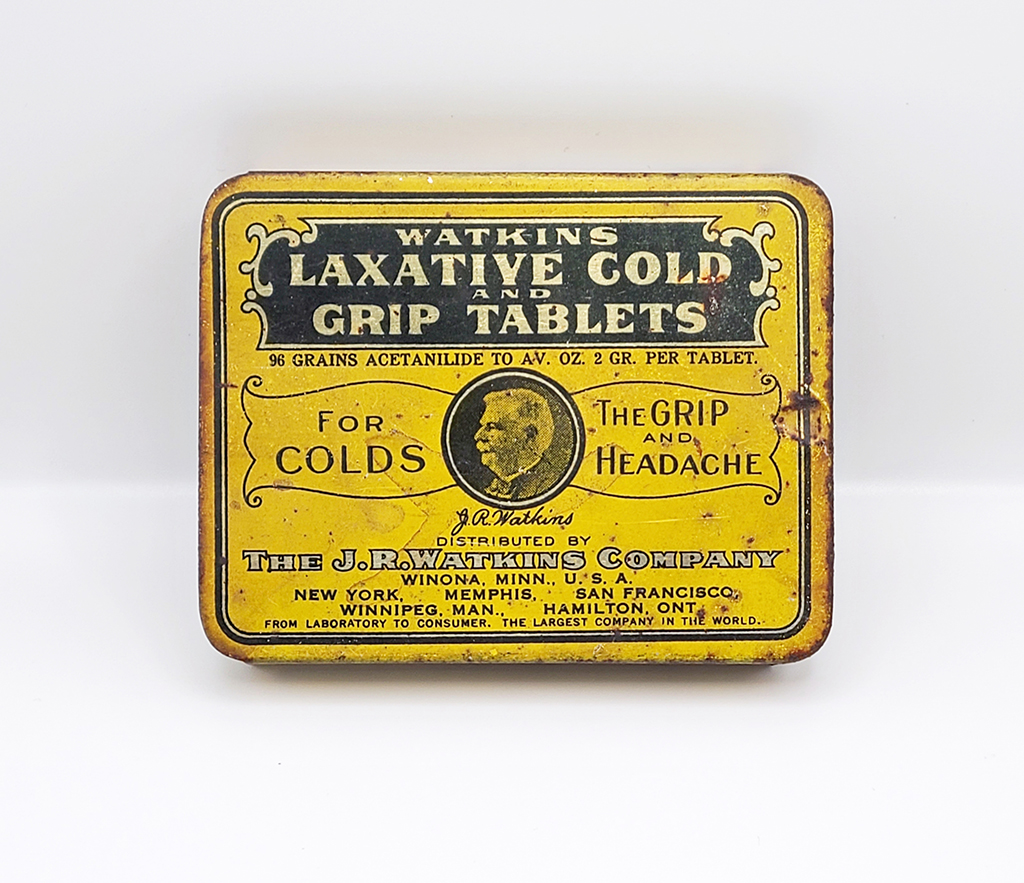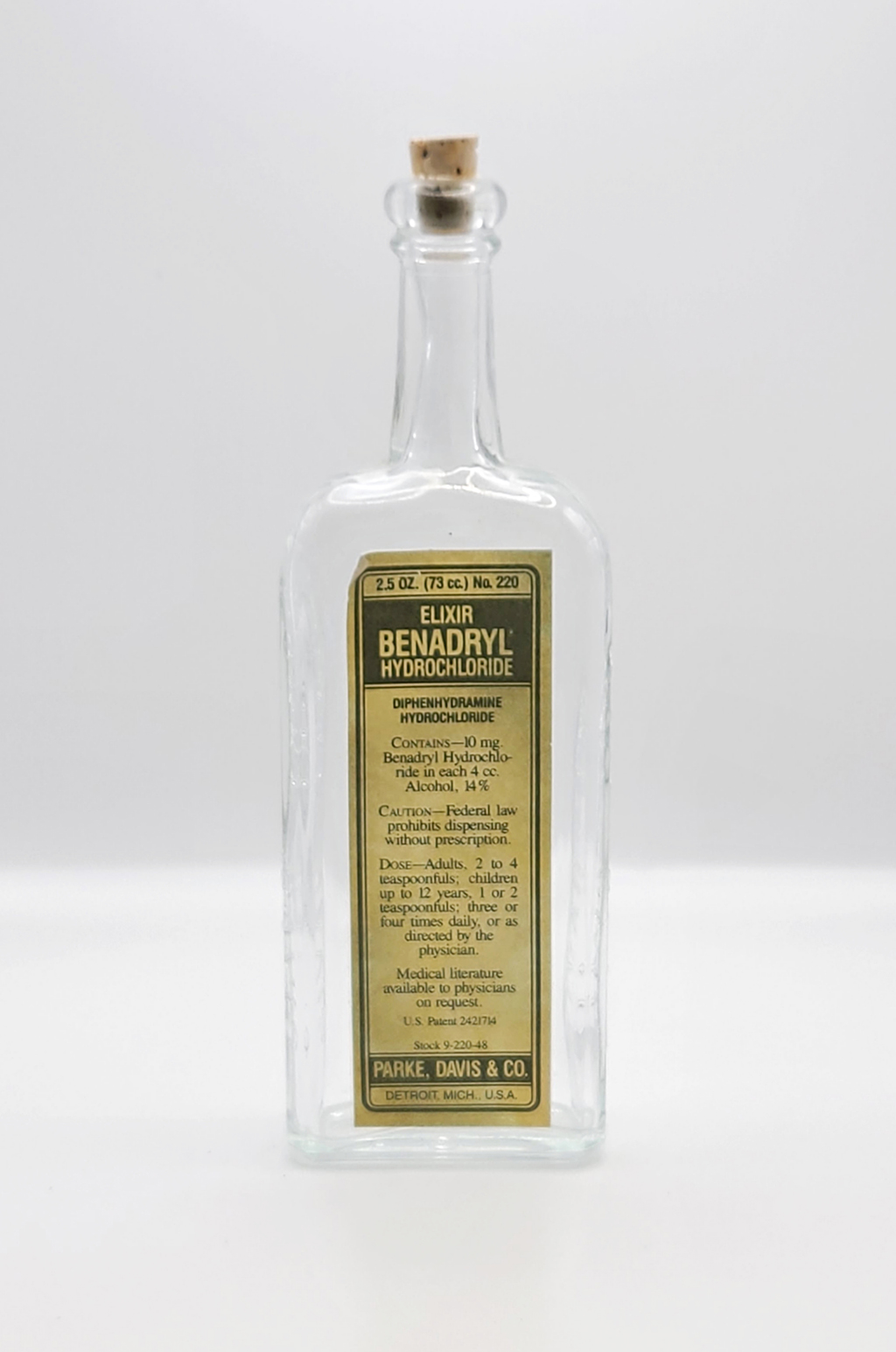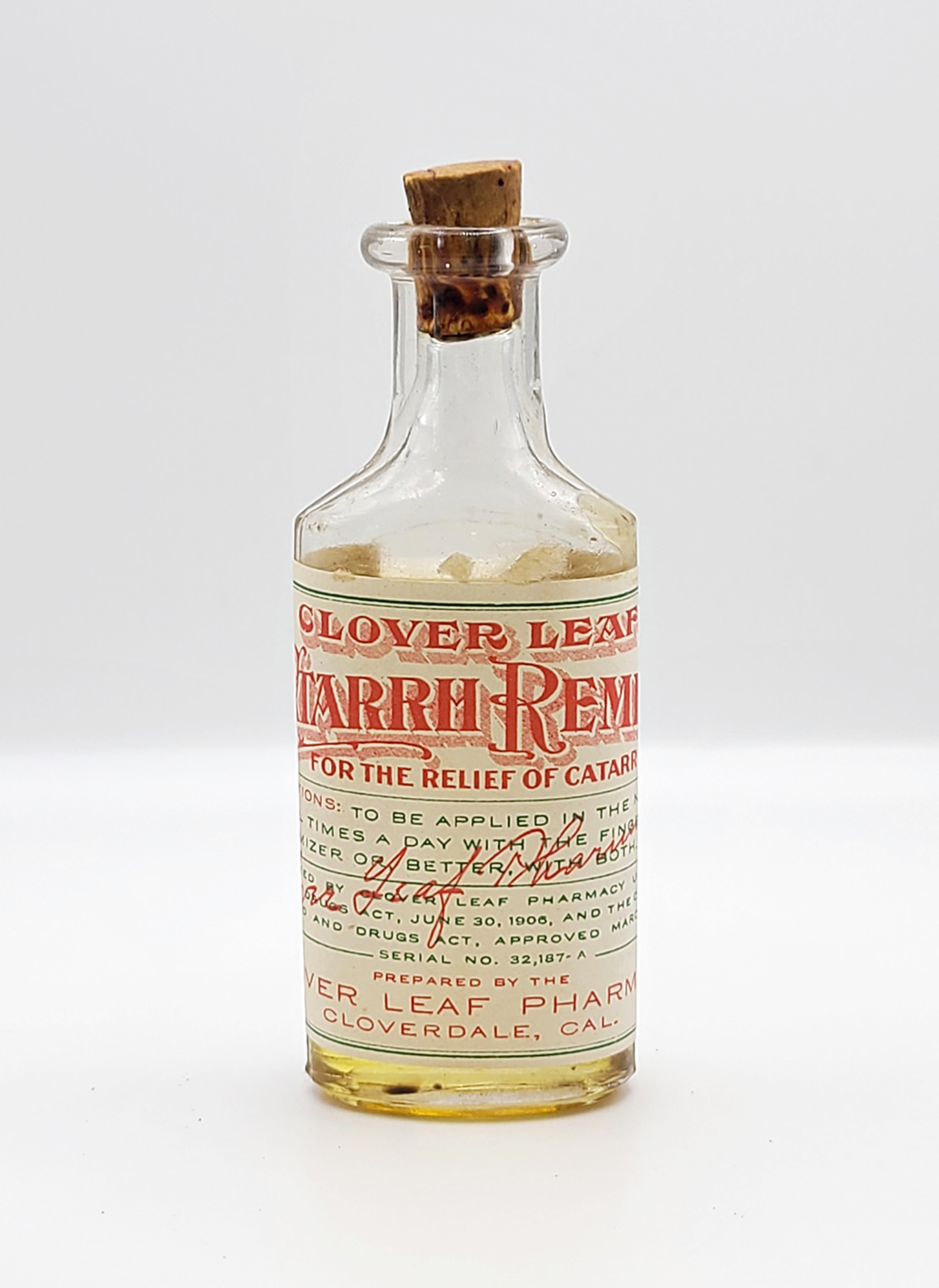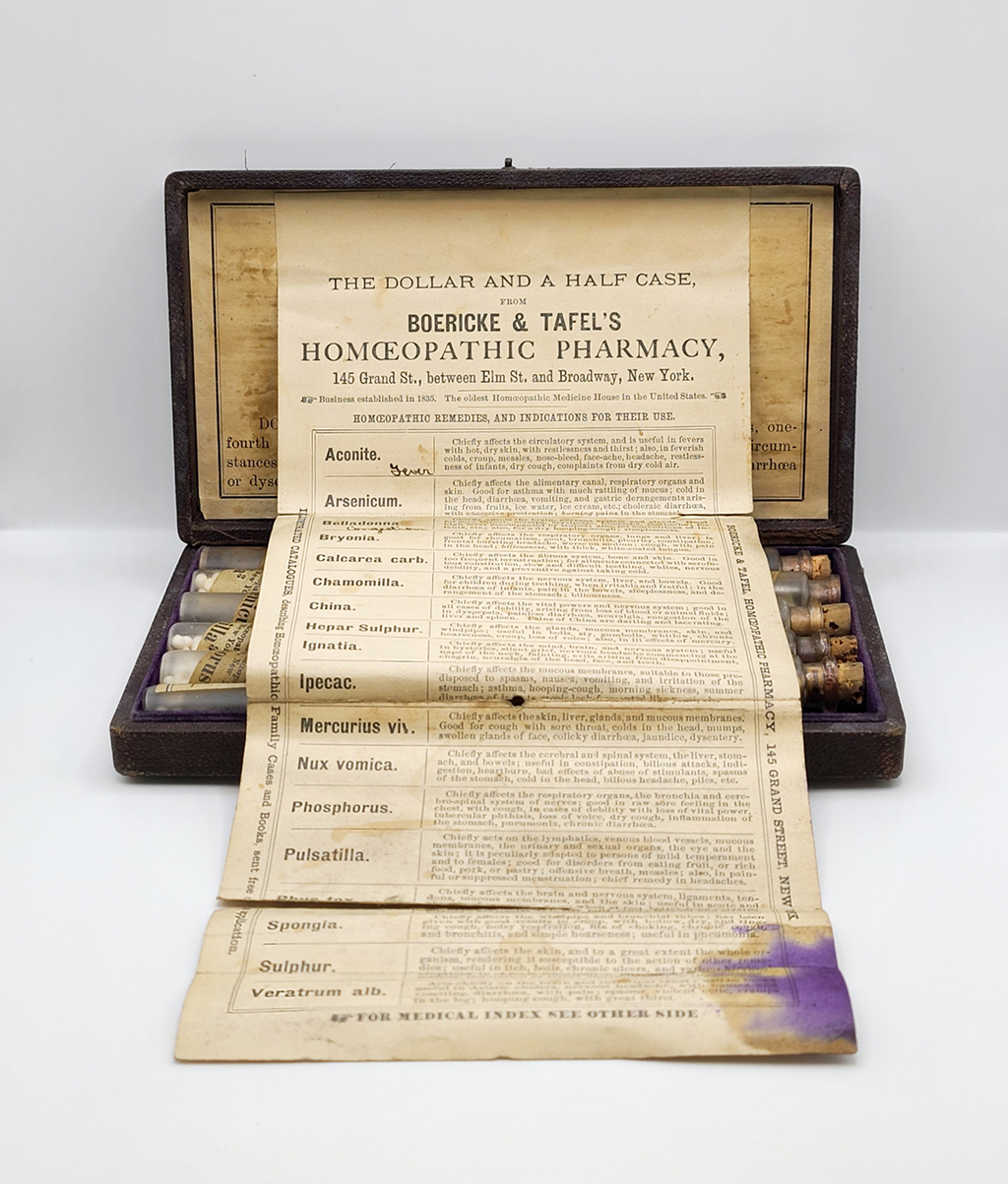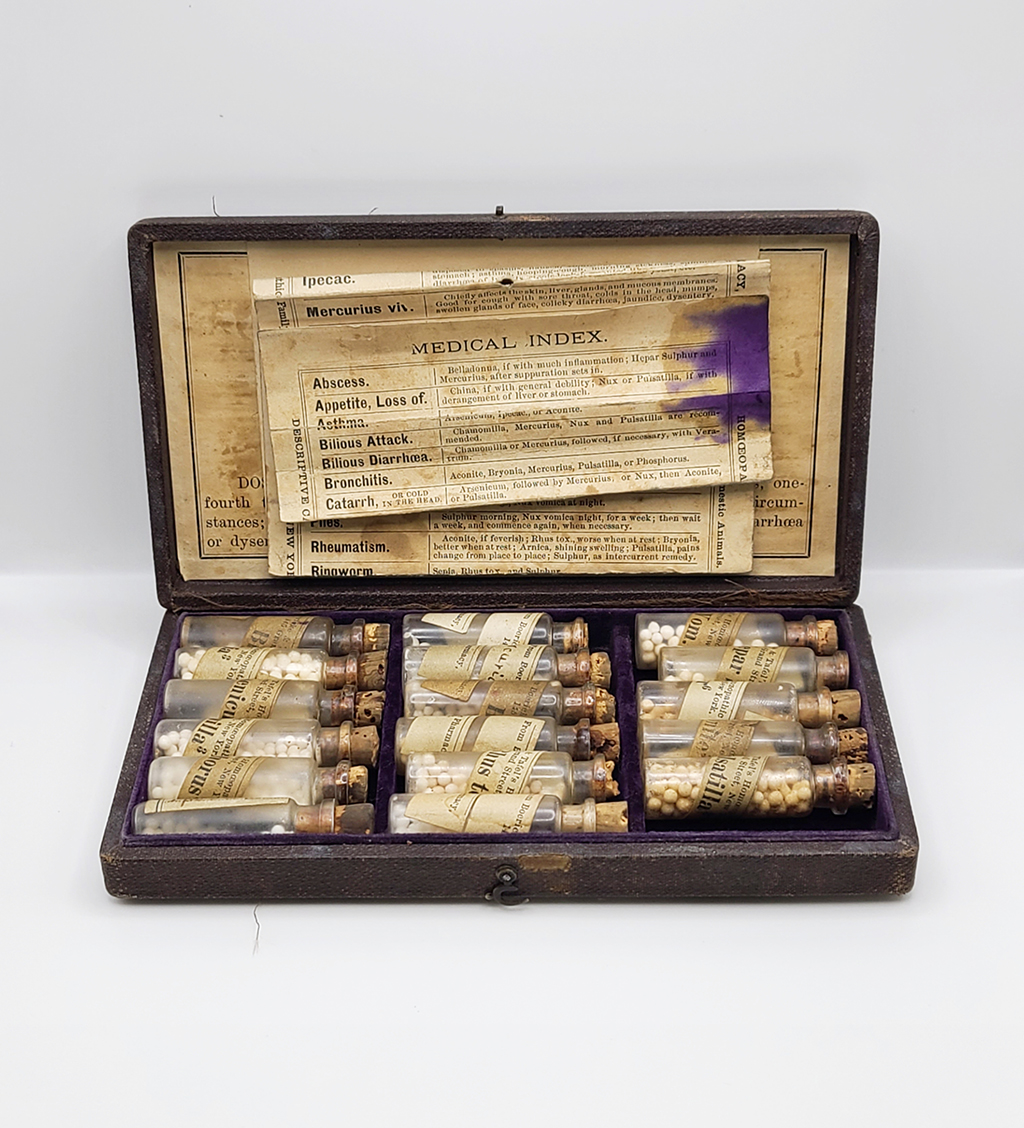There’s a Cure for That: Historic Medicines and Cure-alls in America
Curated by Maria Cunningham, Director of Special Collections. Last updated October 2023.
Patent Medicines and Poisons: A Glimpse into America's Health History
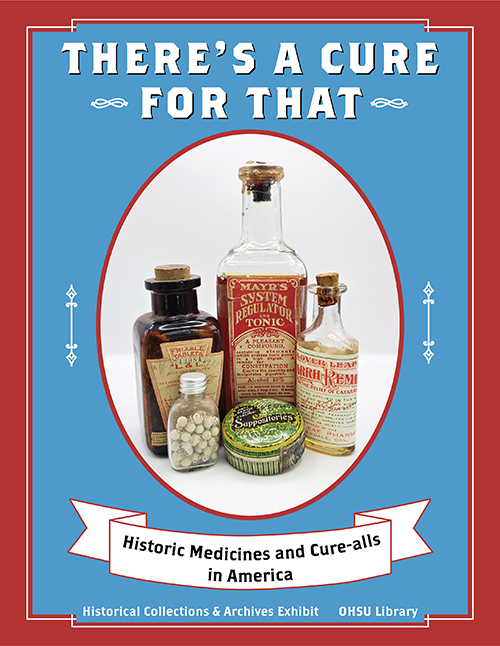
For over two centuries, patent medicines played a significant role in the healthcare landscape of America. The term 'patent medicine' encompasses a wide range of medicinal concoctions produced by doctors, entrepreneurs, and even impostors during the 18th and 19th centuries. Although these medicines were rarely patented in the legal sense, they ultimately paved the way for over-the-counter drugs, which could be obtained without a physician's prescription. Often marketed as "cure-alls," they relied on patient testimonials and aggressive advertising to claim miraculous results.
In the early 18th century, Americans relied heavily on imported English medicines and remedies. The term 'patent medicine' itself originated from English patent medicines, whose ingredients were granted royal protection and exclusivity. However, following the Revolutionary War, a growing preference for American-made products led to the emergence of a new market for homegrown patent medicines. This shift marked the birth of the modern medical market in America.
This exhibit offers a fascinating glimpse into the world of patent and trade medicines from this era, documenting their profound influence on the evolution of medicine and healthcare in the United States.
Dubious Claims and Harmful Products
In the present day, we are well aware of the harm associated with patent medicines. However, during the 19th century, they often appeared as more accessible alternatives to the treatments offered by doctors. Medical practices of that era were rudimentary, with physicians following the principles of humoral medicine, which focused on maintaining balance within the body's four key substances: blood, phlegm, black bile, and yellow bile. This approach relied on practices like bloodletting, purges, and laxatives to achieve this balance. Many doctors also prescribed medications containing harsh chemicals such as mercury or opium. During this time, the emerging medical profession had limited knowledge of the dangers and addictive properties of these chemicals. Shown here are some examples of the harmful medications that were prescribed.
For the general public, patent medicines presented an affordable and easily accessible alternative to medical care. In contrast, medical treatment by doctors was often costly, and many individuals could not afford it. Furthermore, numerous people lived in remote areas where access to doctors was limited. Bringing a doctor to a rural area involved additional expenses, including charges for each mile traveled on top of the visit fee. Patent medicines appealed to consumers because they could be ordered through the mail, and kits of medicines for common ailments were available. The term 'patent medicine' inspired confidence among consumers, yet these medicines often failed to deliver on their promises. While they could provide temporary relief, this was largely due to the liberal use of alcohol and opiates.
Many of these concoctions contained a blend of vegetable compounds mixed with alcohol, morphine, opium, or cocaine. It wasn't until the passage of the 1906 Pure Food and Drugs Act that Congress banned the use of dangerous or addictive ingredients in drugs, marking a significant turning point in the regulation of healthcare products.
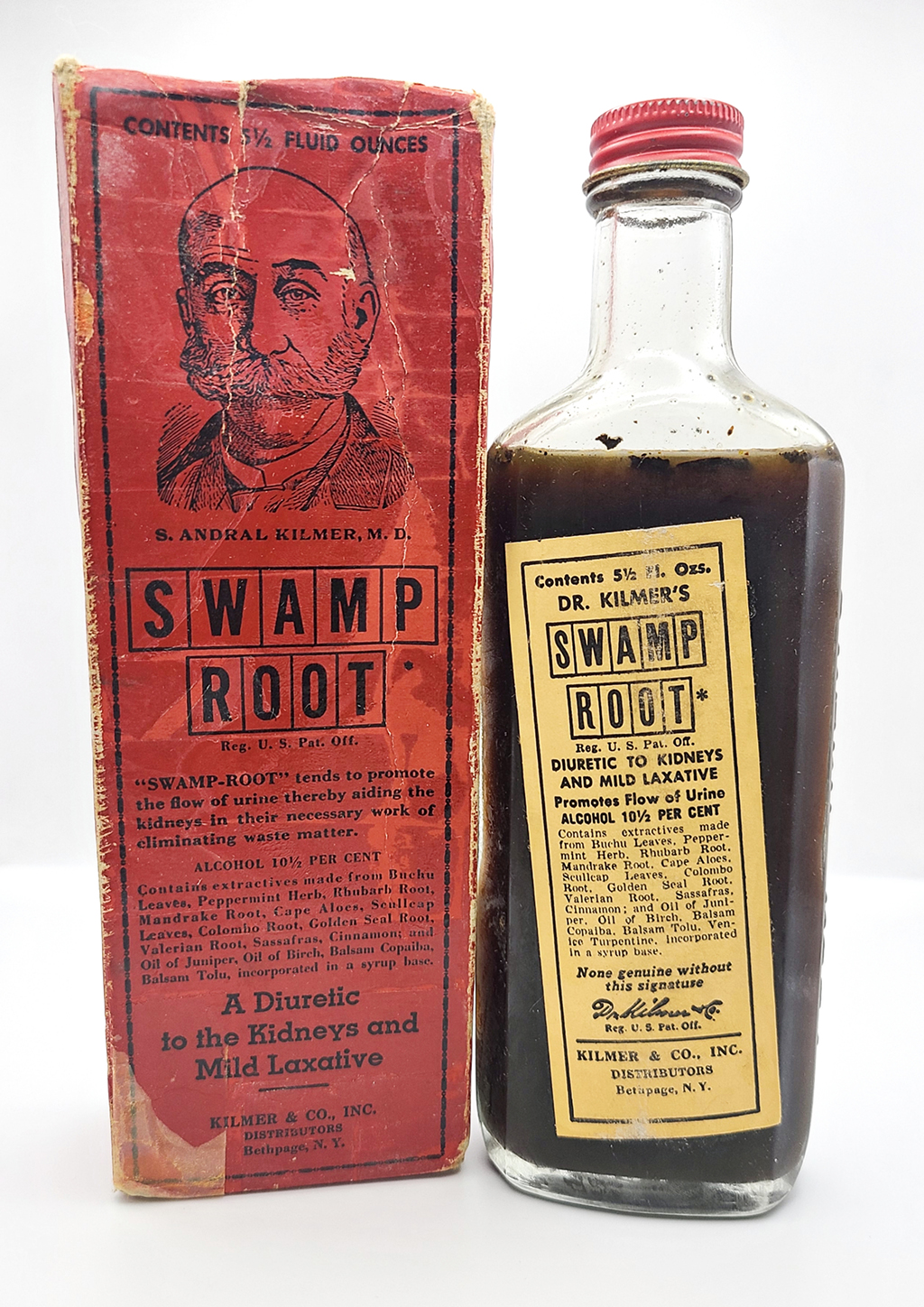
A homeopathic physician, Dr. Sylvester Andral Kilmer founded his laboratory and remedy company in the 1870s. Kilmer’s cure-alls contained various herbs, roots, and plenty of alcohol. The company was taken over by Kilmer’s brother and his sons who developed an aggressive marketing strategy that made Dr. Kilmer a household name.
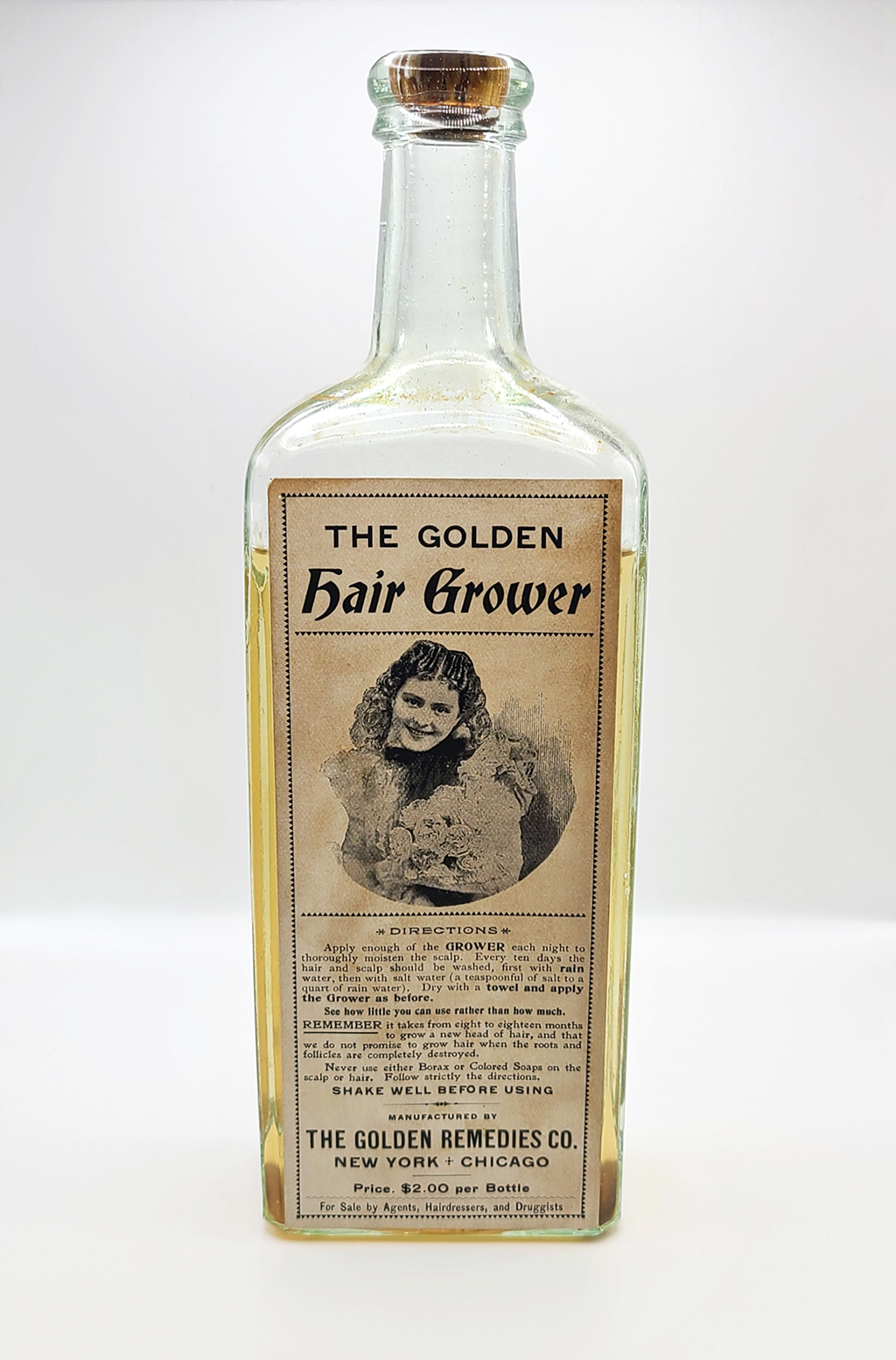
Not much is known about the creator or company behind this hair remedy. It is likely the product was not available for long as the company, Golden Remedies Co., was listed as a defunct business in 1904. This product claims to cure baldness within 8-18 months, but its ingredients are unknown.

This concoction was created by Louisiana State Senator Dudley J. LeBlanc. Although he had no medical or pharmaceutical training, LeBlanc began creating patent medicines in 1938 when he founded the Happy Day Headache Powder Company. Described as a “Dietary Supplement”, Hadacol contained about as much alcohol as a bottle of wine which made it very popular in dry counties. Promotion for the product included radio testimonials, fliers, a popular song called the "Hadacol Boogie", a "Captain Hadacol" comic book, and the popular traveling Hadacol Caravan Show.
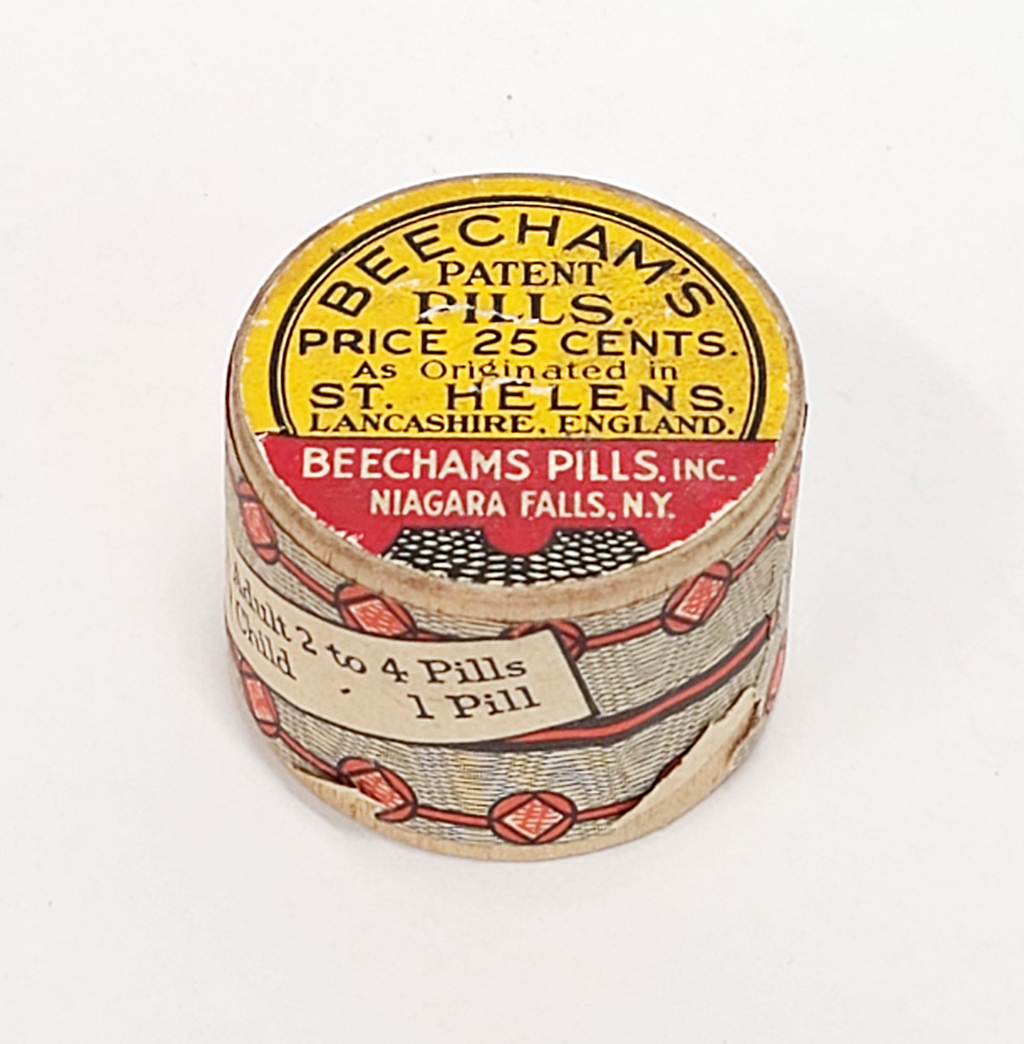
Beecham’s Pills were created by English chemist Thomas Beecham in 1842. They were marketed as a laxative but also claimed to cure such things as headache, dizziness, pain, stomach spasms, lowness of spirits, nervous affectations, pimples, bad legs, and menstrual derangements. These pills, composed of aloe, powdered soap, and powdered ginger, were actually effective laxatives and were very popular. Beecham’s pharmaceutical company eventually merged with an American company, GlaxoSmithKline, who continues to use the Beecham's brand name to this day.
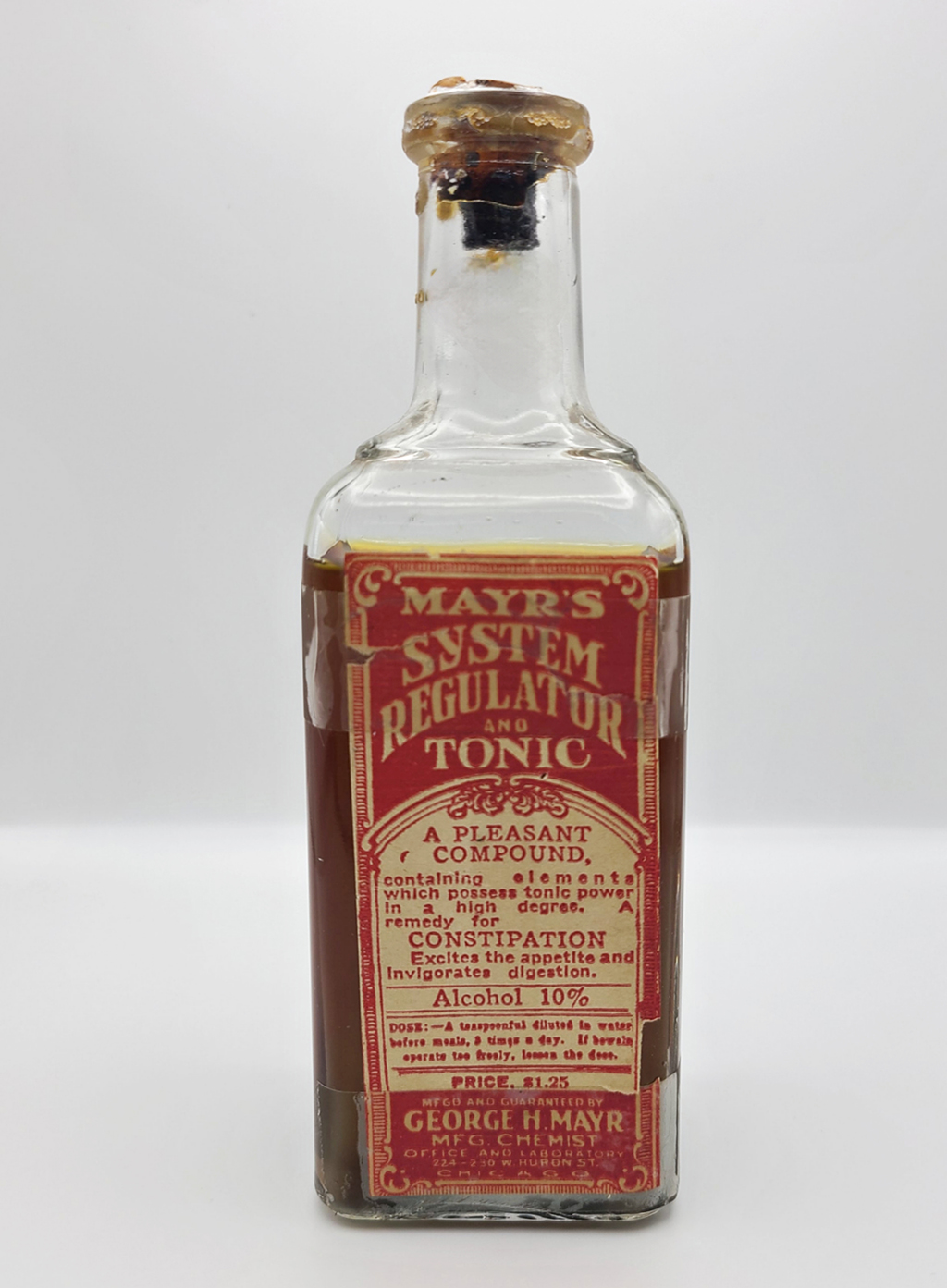
George H. Mayr’s products quickly caught the attention of federal authorities for their fraudulent claims and advertisements. This “medicine” was found to be a tincture containing aloes, salicylates, sweetener, and a healthy dose of alcohol. Mayr was charged, fined, and had the misbranded products seized by authorities.
That Poison Problem
The Industrial Revolution made it possible to cheaply produce new drugs, cleaners, and pest control products. This resulted in lots of new poisonous substances on the market. Many people were illiterate and accidental poisonings and deaths were common. To combat this, poison product bottles had to have distinctive colors, shapes, and designs to distinguish them. These bottles often came in colors like cobalt blue, dark black, dark green, or amber. They also featured raised lettering, patterns, deep grooves, geometric shapes, or skull and crossbones symbols.
Different medical groups proposed ways to keep the public safe. In 1853, the American Pharmaceutical Association recommended using the death’s head symbol, a skull and crossed bones, and including a poison label. In 1872, the American Medical Association recommended labelling the bottles with the word poison and including rough texturing along one side. While these measures helped adults distinguish the contents, little thought was given to how children would react to them. It wasn’t until the 1930s that the medical community realized that colorful and uniquely shaped bottles were especially attractive to children. This resulted in a switch to plainer (and less esthetically pleasing) bottles.
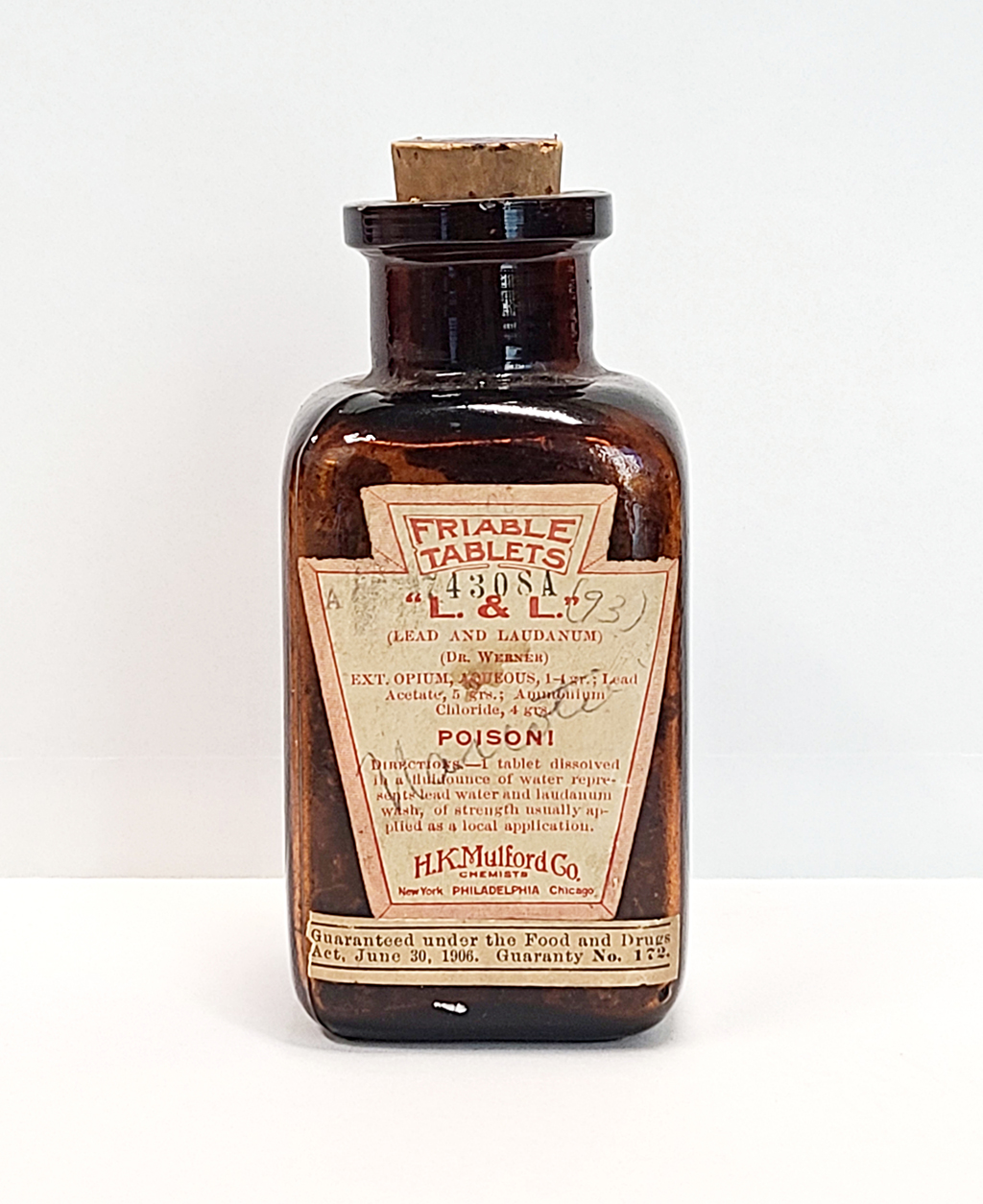
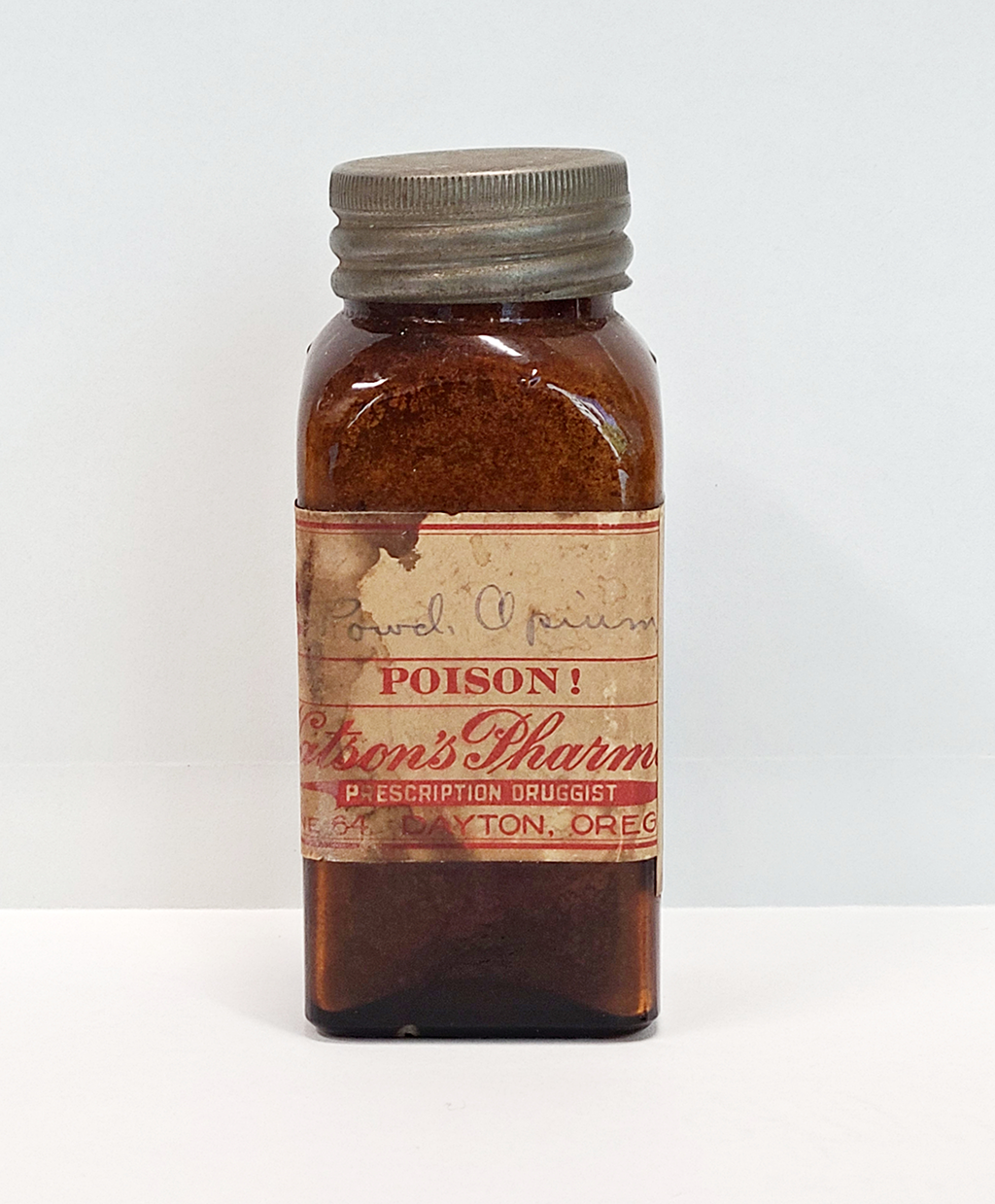
Opium is an addictive drug made from the juice of the opium poppy plant. Laudanum is a tincture of opium that is prepared by adding powdered opium to alcohol. Opium has been used in medicine, rituals, and cooking by several societies since about 5000 BCE. While these medications don’t indicate what they treated, opium and laudanum were routinely prescribed for conditions such as sleeplessness, fever, headache, cough, bladder inflammation, diarrhea, nervous disorders, and more.
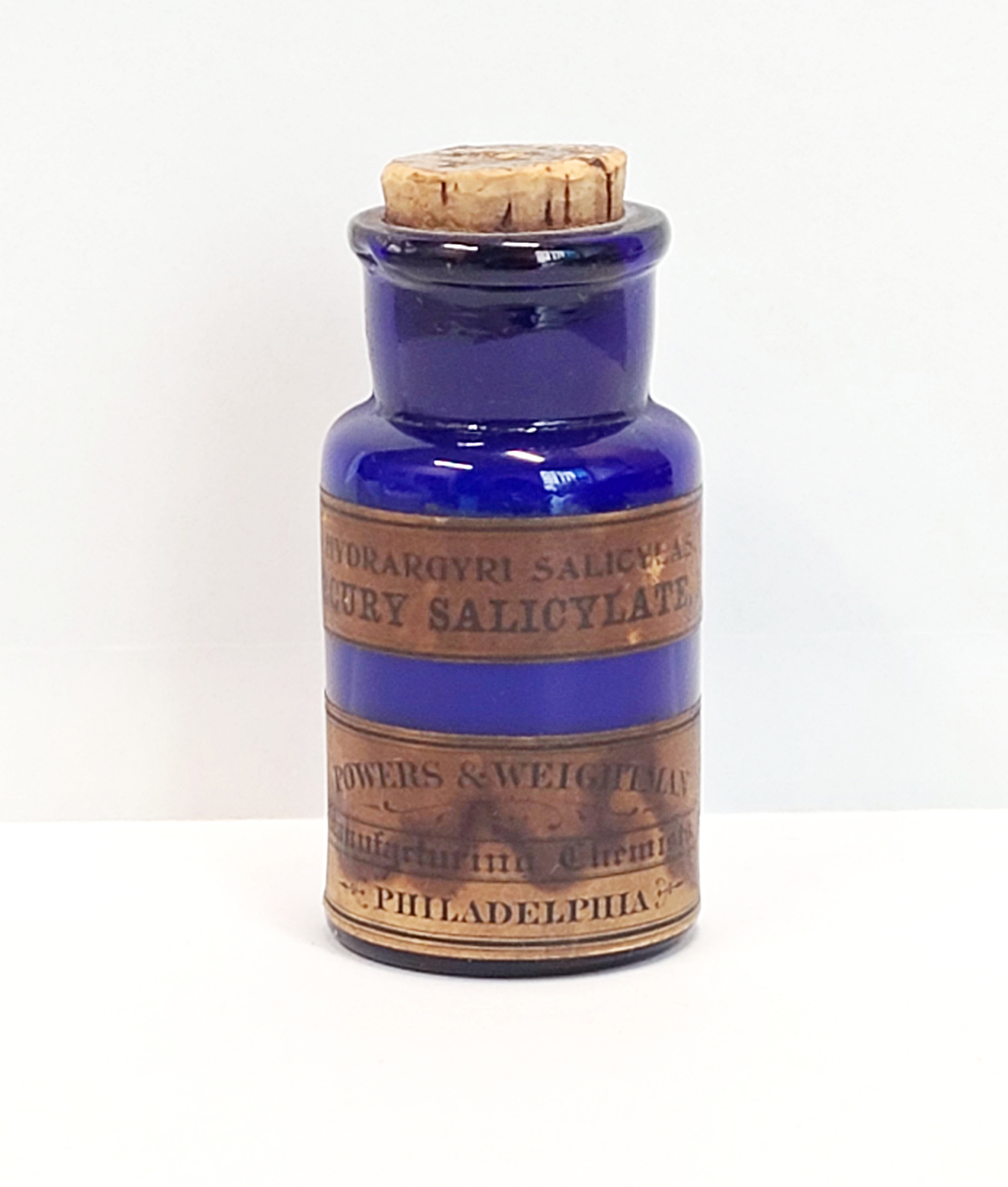
This bottle would have been sold by an apothecary or druggist. Due to the poisonous nature of the material, only patients who had a prescription from their doctor would’ve been able to purchase it. Mercury and mercury-containing preparations have long been used in medicine to treat such conditions as bacteria, fungus, syphilis, and yeast infections. The bright blue color was used to distinguish poison bottles from any food or medicine bottle.
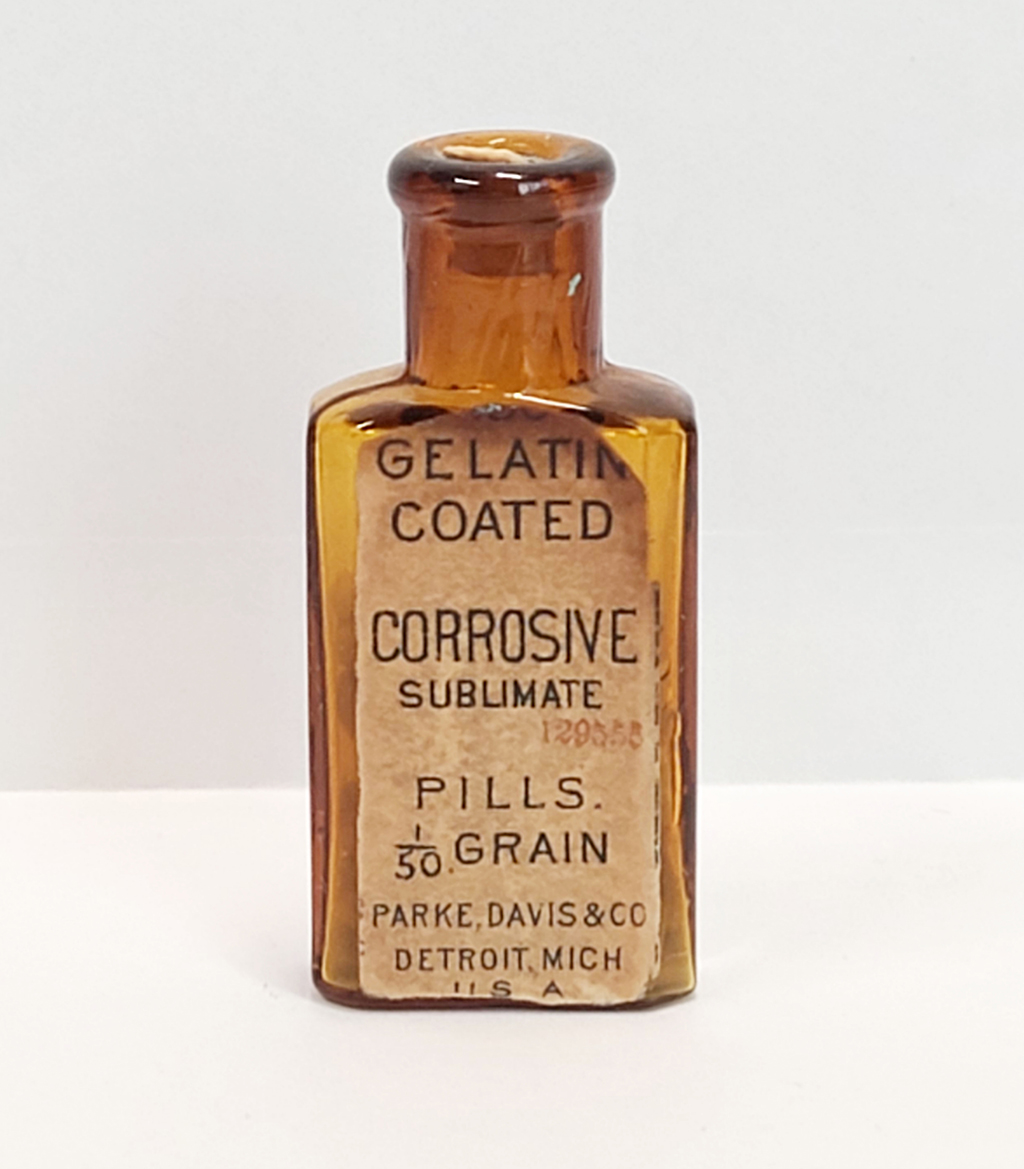
A highly poisonous compound, corrosive sublimate was used in photography, pest control, preservation, and medicine. It is more commonly known under its contemporary name of mercury chloride. In the early 20th century, it was a common over-the-counter cure for measles and syphilis and often used as antiseptic and disinfectant. It was responsible for many accidental poisonings, suicides, and suspected murders.
All About the Bowels
In the late 1700s and early 1800s, physicians in Europe and America increasingly linked constipation to various health issues, influenced by changing diets and lifestyles in urban settings. By the early 19th century, constipation was widely regarded as the primary ailment of civilized society. Both doctors and the public believed that diseases stemmed from an imbalance in bodily functions, emphasizing the need to regulate secretions like blood, sweat, urine, and feces for restoring health. Consequently, a plethora of laxatives and purges flooded the market, all promising to regulate bodily systems and reestablish equilibrium. Although many of these remedies did successfully purge the system, several were poisonous in large doses and produced unpleasant side effects.
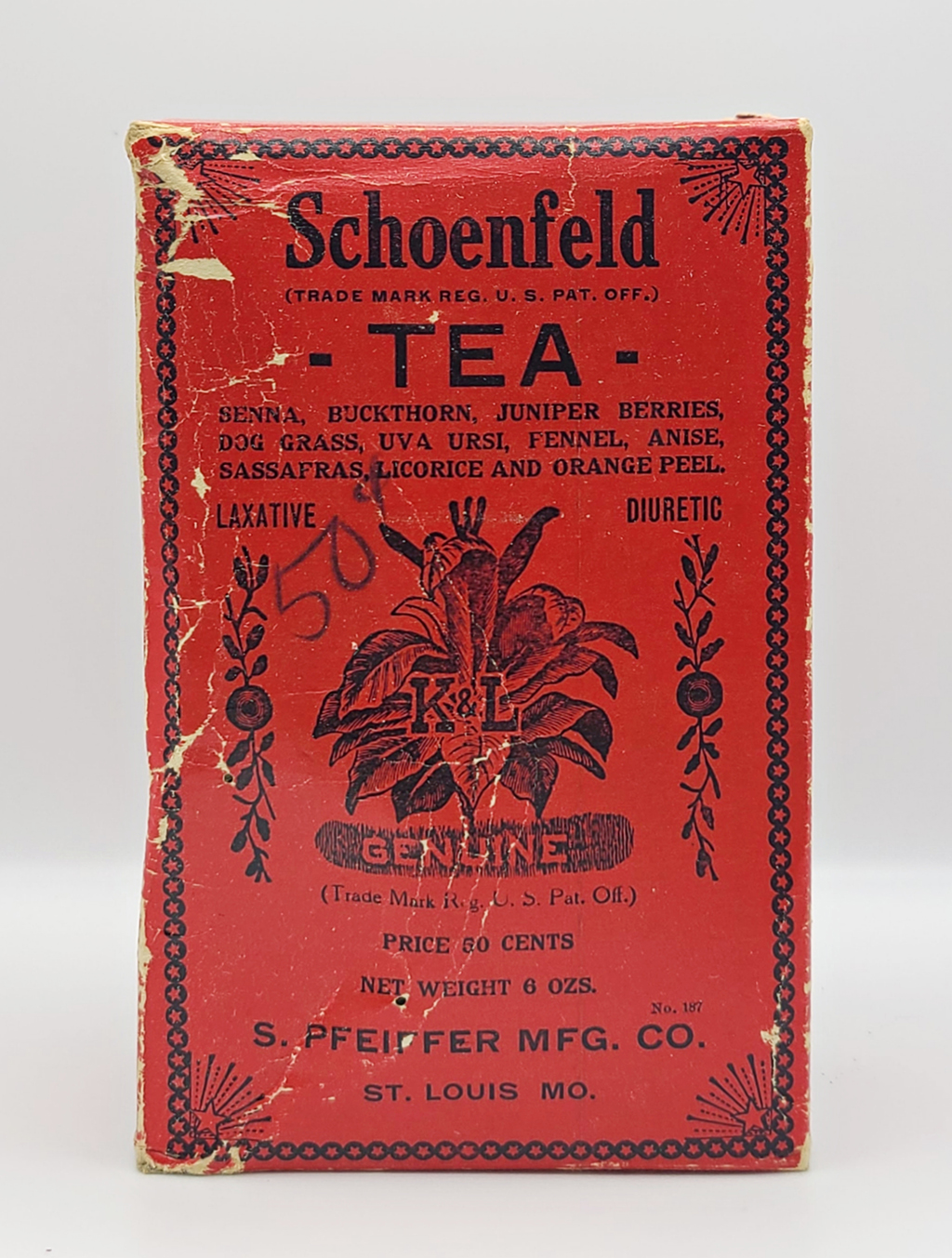
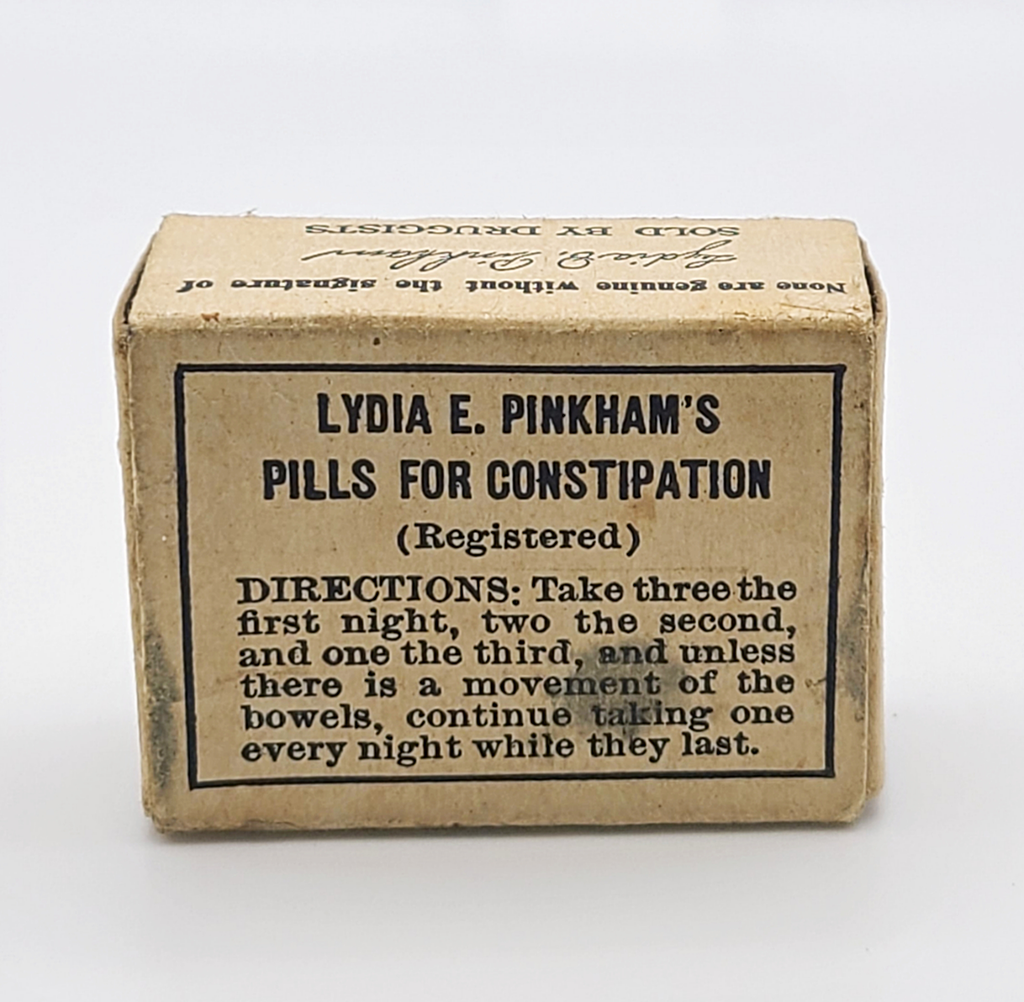
Women’s Health
In the 18th and 19th centuries, medical treatment for women came with many challenges. Due to societal norms of propriety, many women felt uncomfortable discussing their own bodies or asking questions about their health. When they did address their concerns, they often used euphemisms or veiled terms. With the medical profession predominantly composed of men, women's health often received inadequate attention, leading to unrecognized symptoms and dismissive treatment. Prevailing medical beliefs portrayed women as inherently weaker and more prone to illness, often unfairly attributing blame to the uterus.
However, pharmacists, advertisers, and creators of patent medicines quickly recognized the opportunity to cater to this underserved demographic, leading to the emergence of a dedicated branch within the patent medicine industry. Though often ineffective and harmful, these remedies empowered women to take control of their well-being, offering privacy and convenience through mail-order delivery.
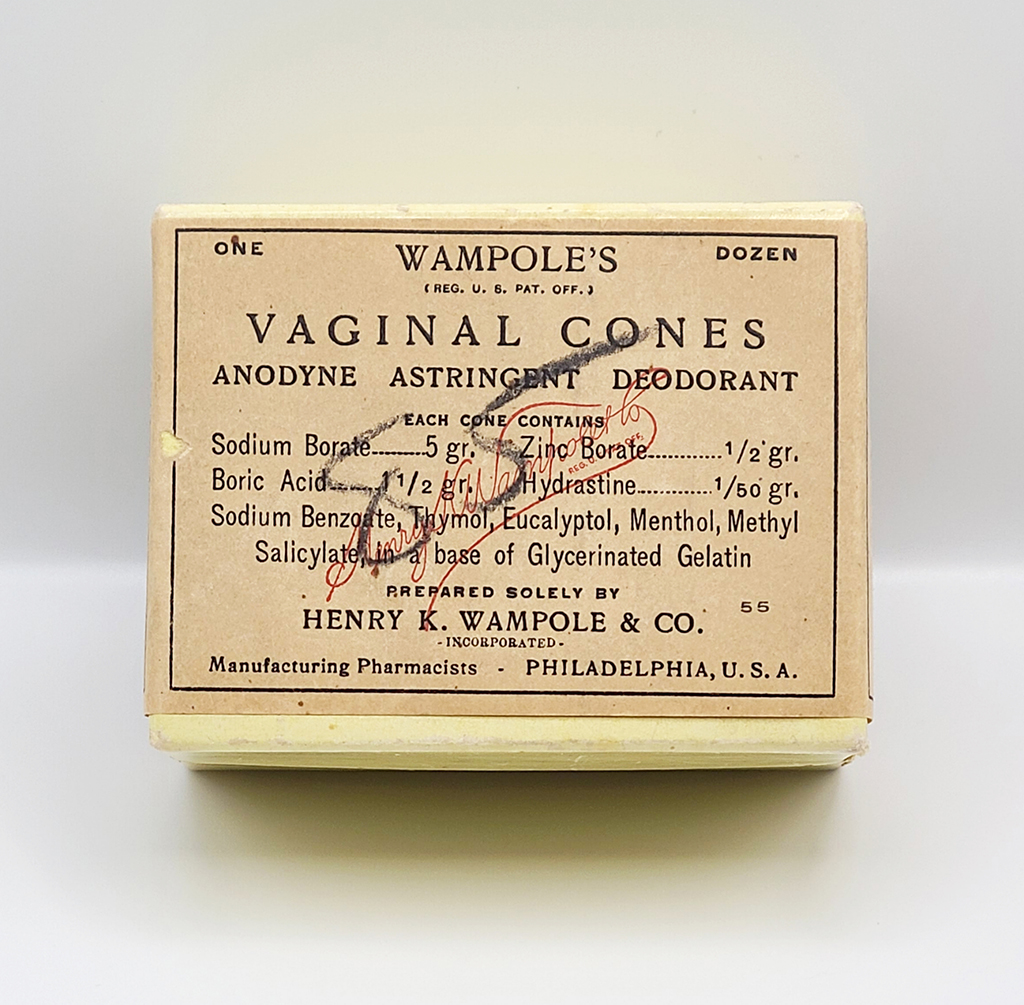
This product, created by pharmacist Henry K. Wampole, was designed as an antiseptic that both cleaned and deodorized the vagina. It also aimed to treat infections such as gonorrhea and trichomoniasis, and it may have had potential contraceptive properties by inhibiting sperm.
The primary ingredient in these cones was sodium borate, a substance that is still in use today and more commonly known as "20 Mule Team Borax."
Earlier versions incorporated picric acid, a chemical used in artillery shells during World War I. Unfortunately, the use of these cones increased the risk of sexually transmitted infections (STIs) by irritating the vagina and cervix, thereby exposing blood vessels to germs.
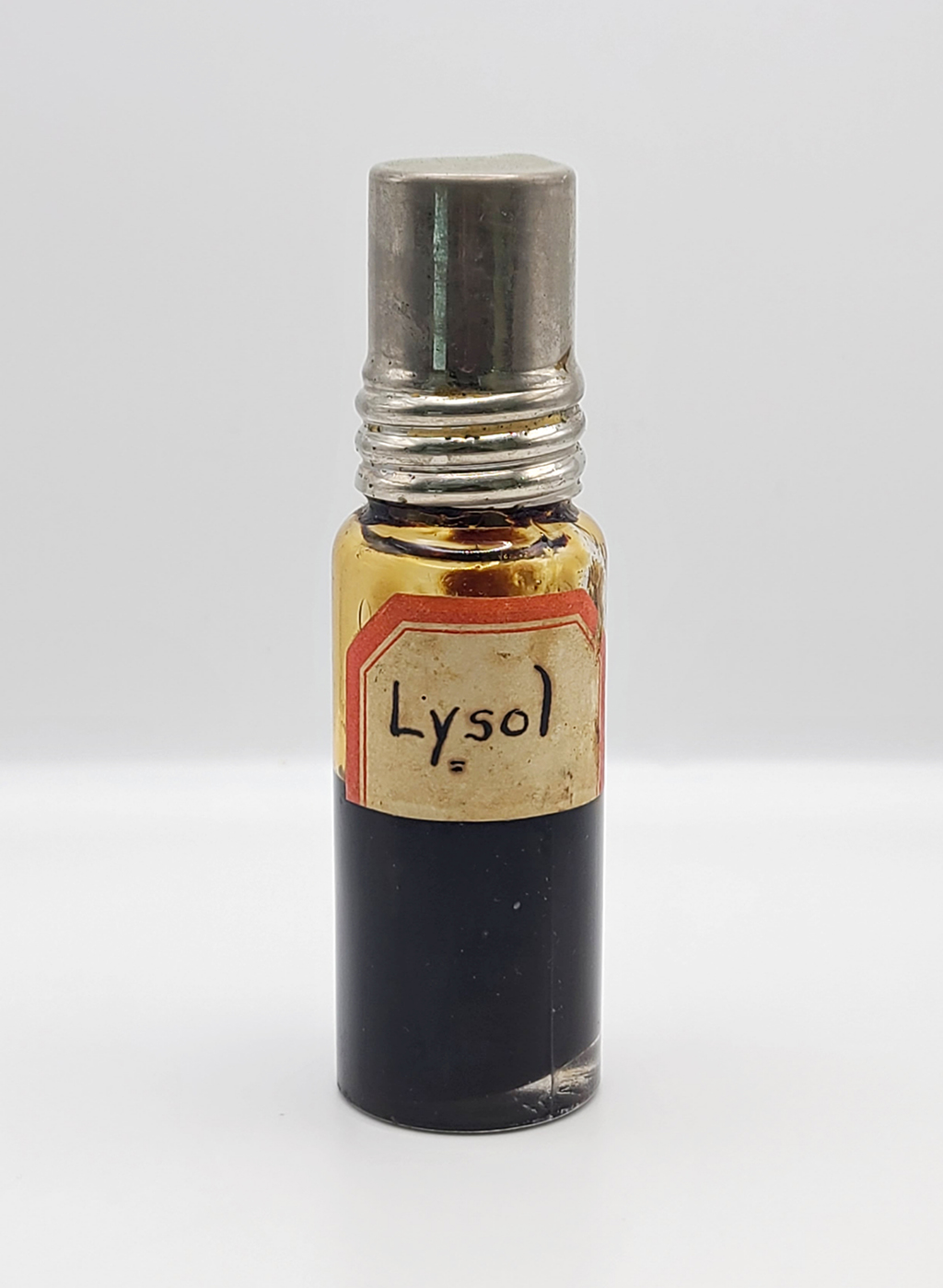
Lysol Disinfectant has a long history as a cleaning product, douche, contraceptive, and abortion aid. Lysol was created in 1889 by Gustav Raupenstrauch. The disinfectant’s early formula included cresol which was reported to cause inflammation, burning, and death. In the early 1920s, the company that made the disinfectant, Lehn & Fink, aggressively marketed the product to American wives. These advertisements stoked women’s fears of turning away their husbands due to odor and uncleanliness. These ads also used euphemisms that hinted at Lysol’s effectiveness as a contraceptive and abortion aid.
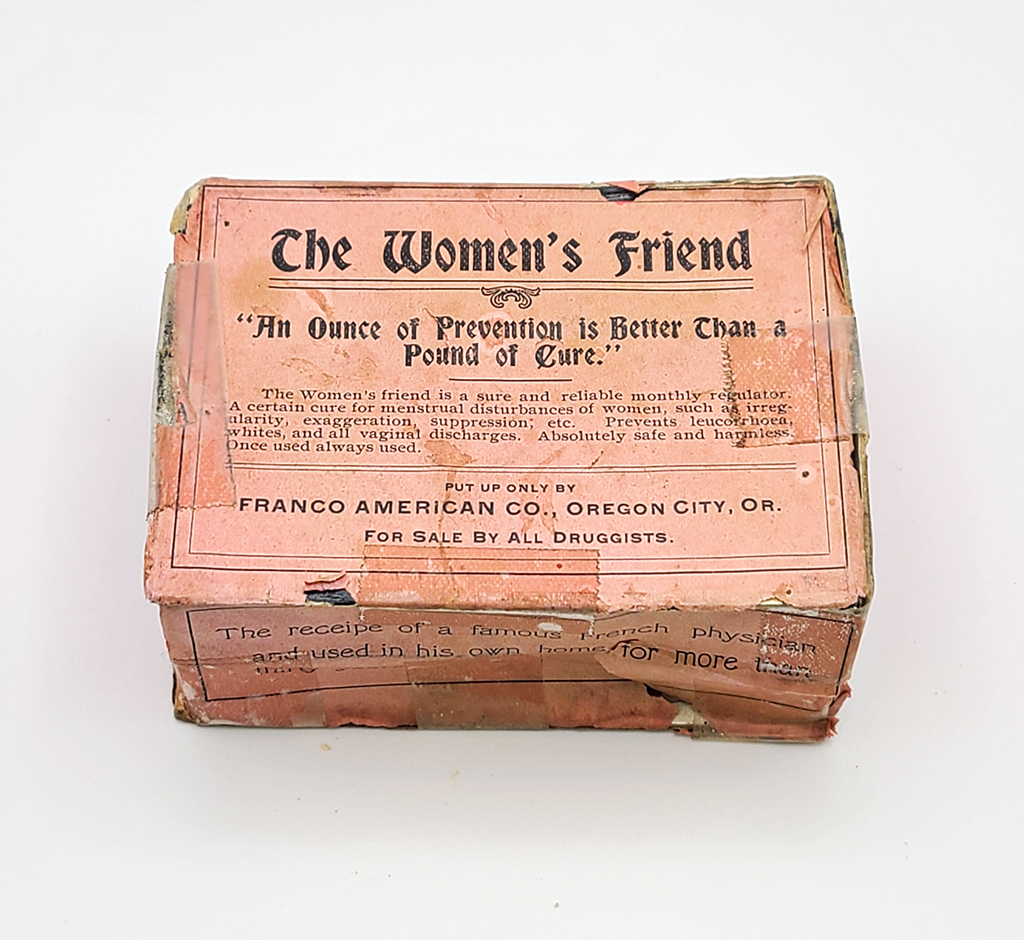
Little is known about this product or the Oregon company that produced it. It claimed to cure menstrual disturbances such as irregularity, suppression, and leucorrhea (a medical term for discharge). The fact that the instructions direct the user to use after sex suggests that it may also have been used as birth control.
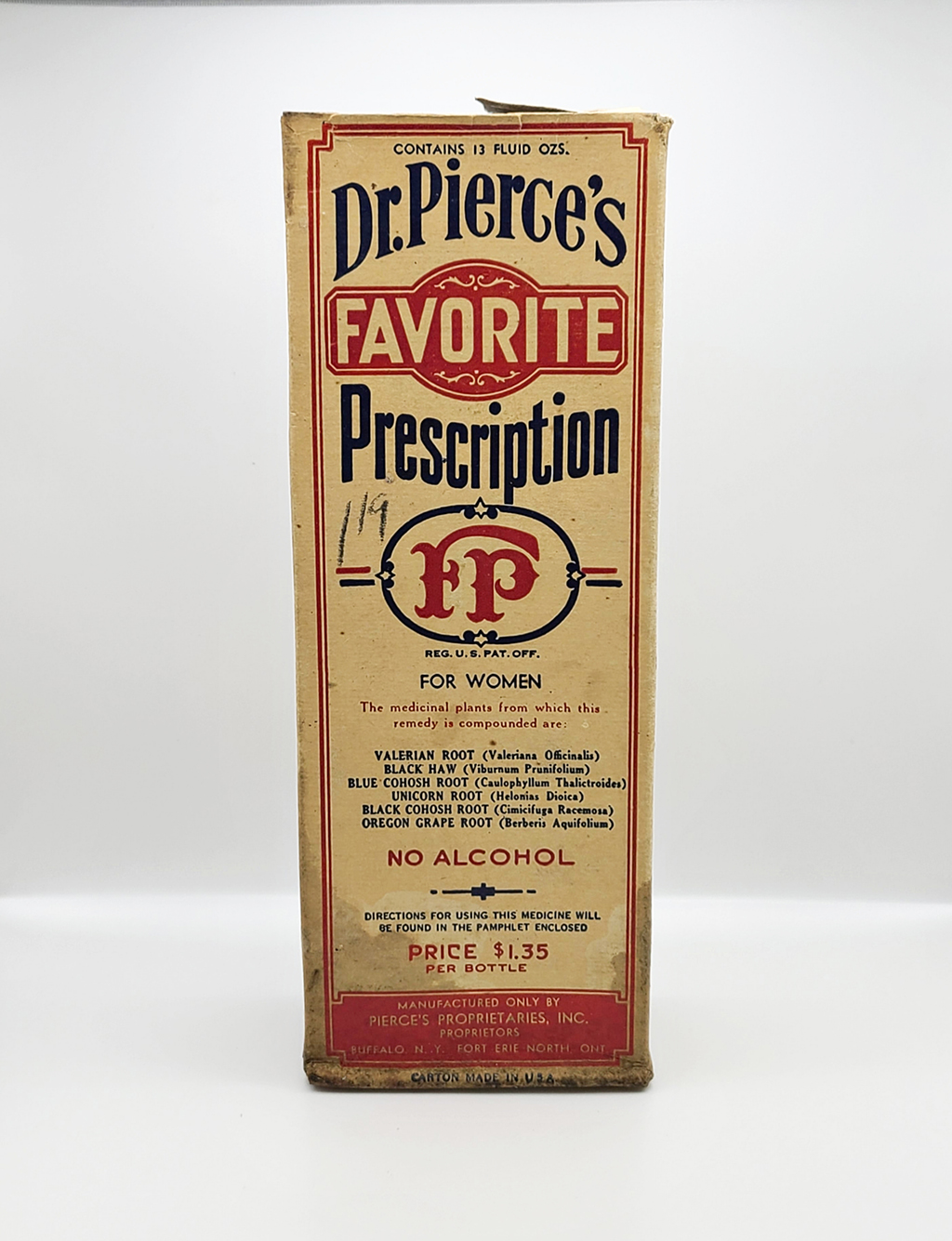
Dr. Ray Vaughn Pierce was the nation’s leading seller of mail-order patent medicines. Trained as a doctor, he created his first medicine “Dr. Pierce's Favorite Prescription” in 1867. Dr. Pierce said of his Favorite Prescription: “It makes weak women strong and sick women well.” The medicine claimed to cure nervousness, backache, headache, sleeplessness, mental anxiety, and despondency. And no wonder – before 1890, this medicine was said to contain mostly alcohol and opium tincture.
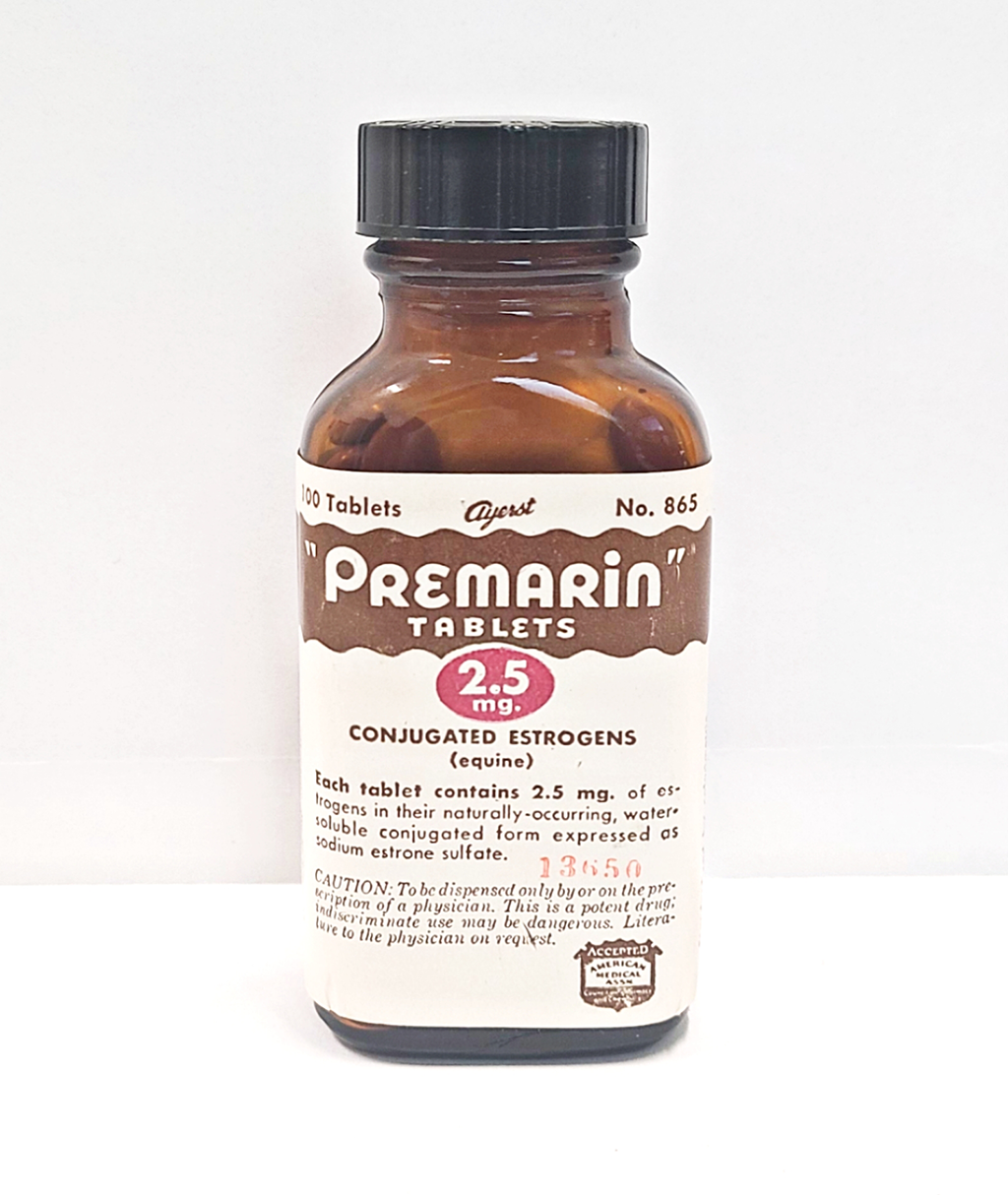
Premarin is an estrogen medication developed by Wyeth Pharmaceuticals in 1942. The name comes from its primary ingredient, pregnant horse urine (PREgnant MARes’ urINe). It is prescribed to relieve the symptoms of menopause, including “hot flashes,” night sweats, and vaginal dryness.
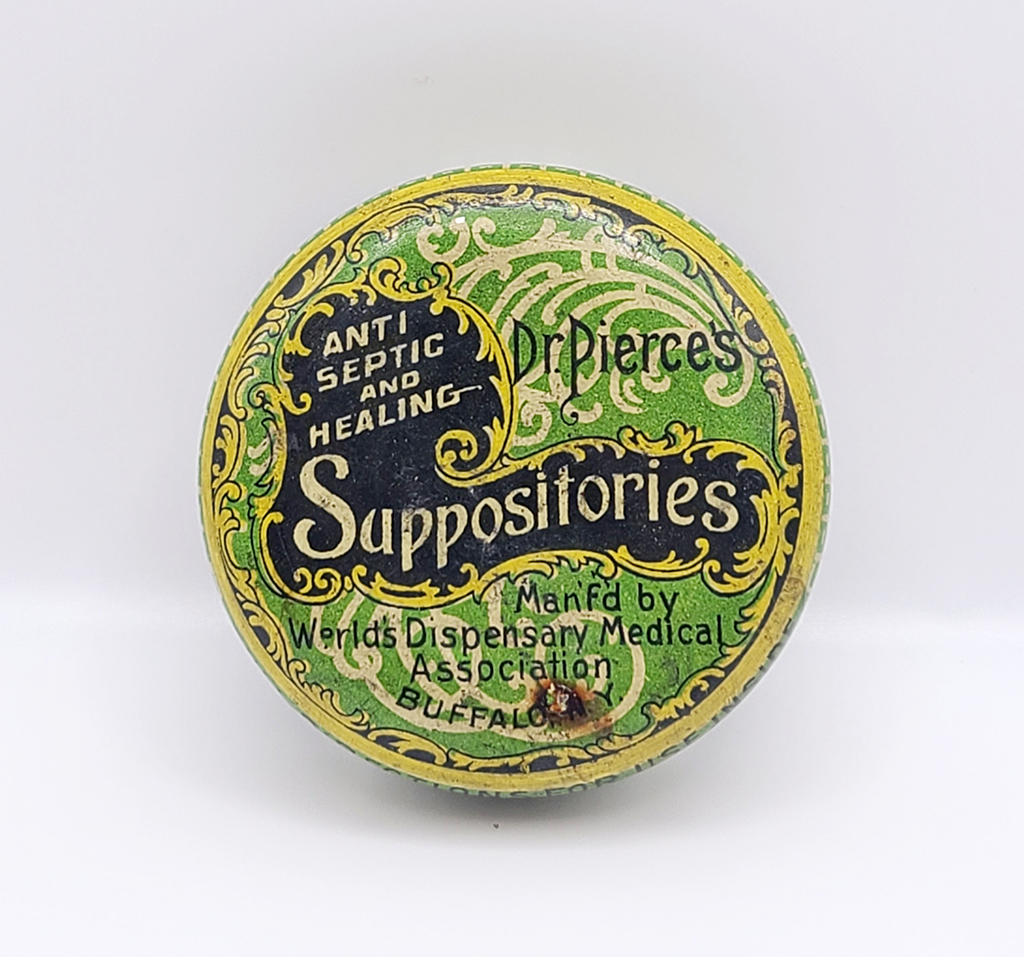
These vaginal suppositories claimed to purify, deodorize, and produce a strengthening effect on the vaginal canal and womb. The ingredients are a mystery, but later versions contained sodium borate (borax).
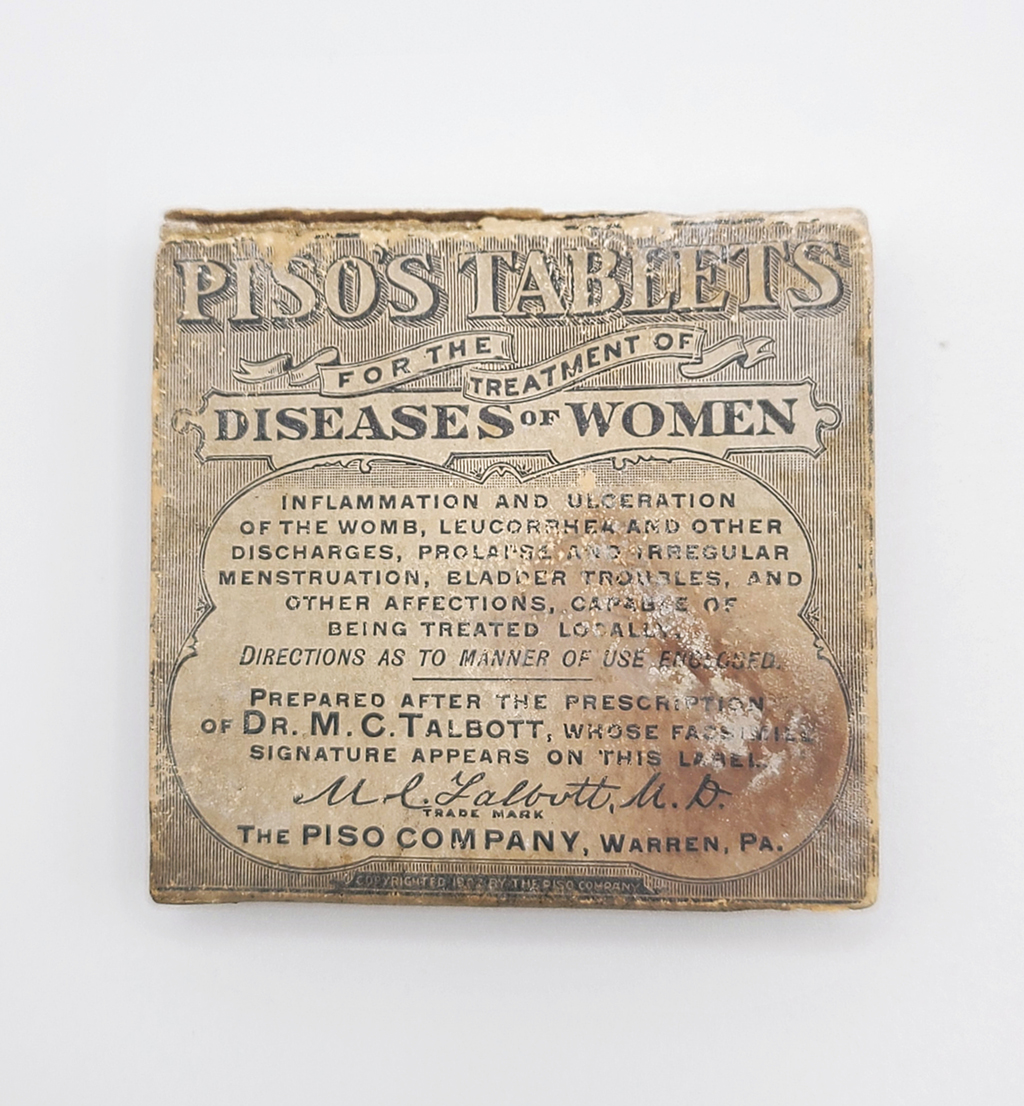
Piso’s tablets were marketed as a remedy for a wide range of ailments, including "diseased womb", dyspepsia, kidney disease, neuralgia, leucorrhea, backache, lumbago, headache, disordered menses, constipation, and urinary troubles.
Early iterations of this medicine included cannabis and chloroform among its ingredients. Over time, it evolved, shedding its opiate content and, eventually, its alcohol and cannabis components. Its reign effectively ended shortly before World War II.
A laboratory analysis revealed that Píso’s ingredients consisted of dried alum, dried borax, boric acid, and water. Interestingly enough, these were the exact ingredients in another Piso’s product called Micajah’s Medicated Uterine Wafers.
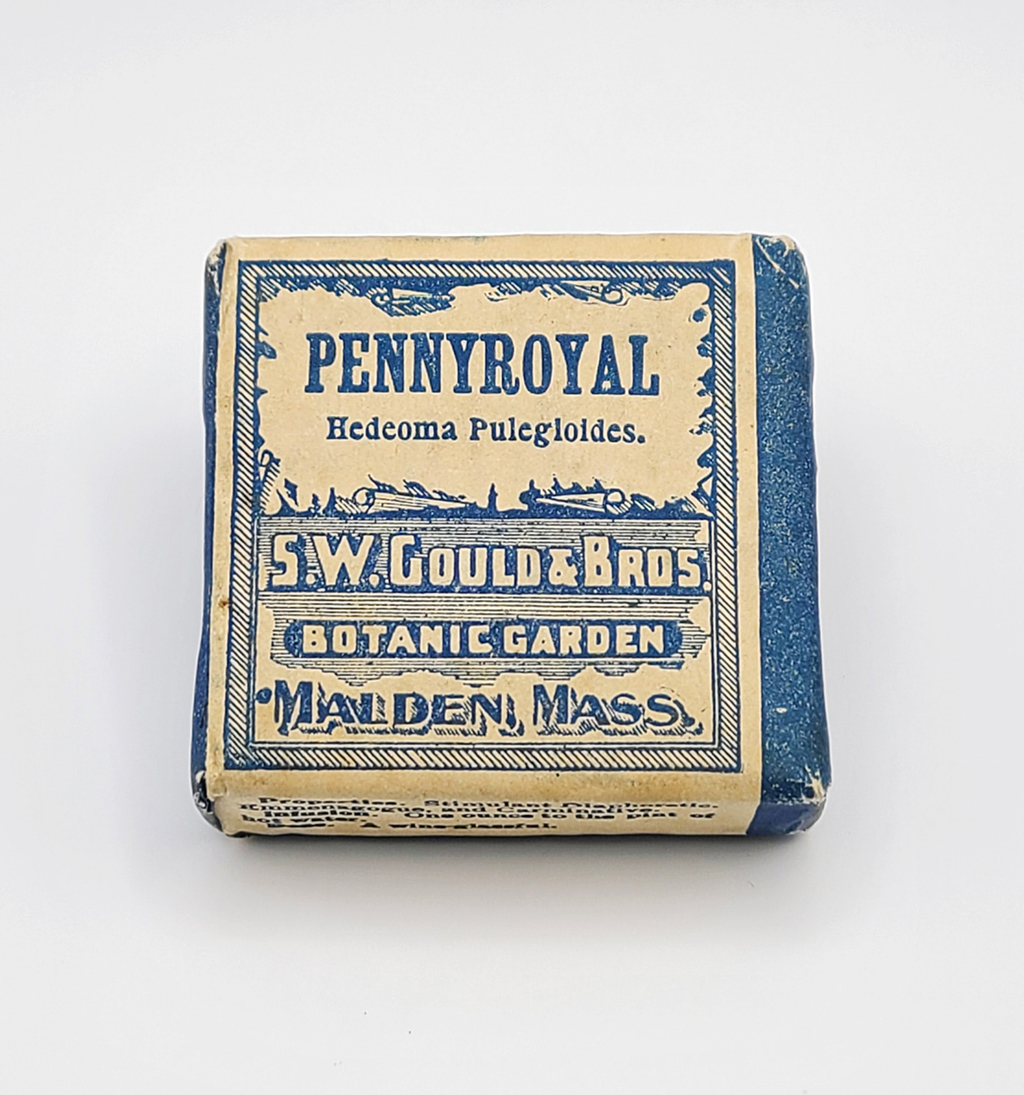
Mentha pulegium, more commonly known as Pennyroyal or the mosquito plant, has documented usage dating back to the ancient Greek and Roman cultures. Though pennyroyal oil is highly toxic, the plant has been used as a cooking herb, insecticide, menstruation stimulant, and abortion aid. Its use as an abortion aid and womb expeller was documented in early medical texts by notable physicians such as Pliny the Elder, Galen, and Nicholas Culpepper.
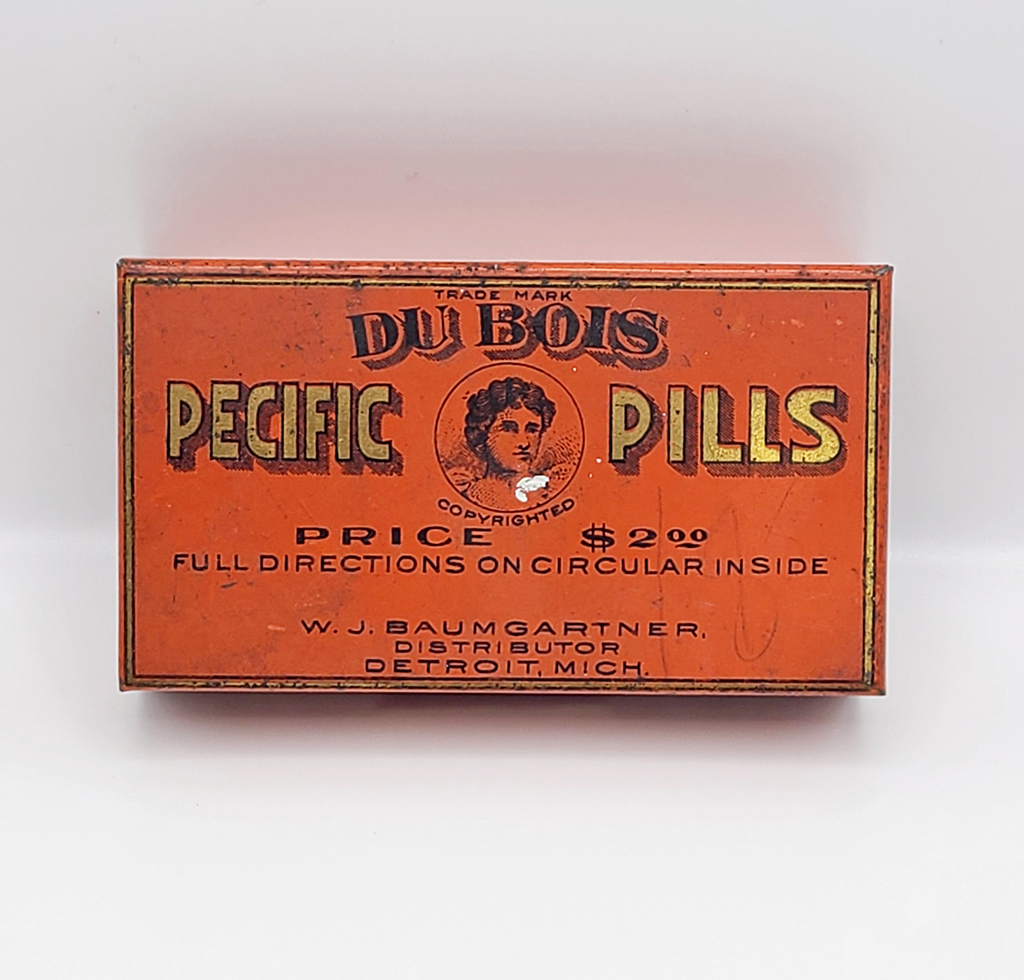
Not much is known about this medicine or the company that created it. Records from the U.S. Department of Chemistry show the company was sued for libel and mis-branding under the 1906 Food and Drugs Act. Tests confirmed that the pills, which claimed to prevent menstrual pain and regulate periods, essentially consisted of aloes and ferrous sulphate coated with calcium carbonate and sugar.
Nose and Throat Remedies
While many patent medicine manufacturers claimed to cure serious diseases like cholera, smallpox, typhus, and yellow fever, few focused on treating the common cold. The medicines here were designed to treat mucous buildup, asthma, allergies, and sore throat. Like other medicines of the day, some contain poisonous and addictive ingredients.
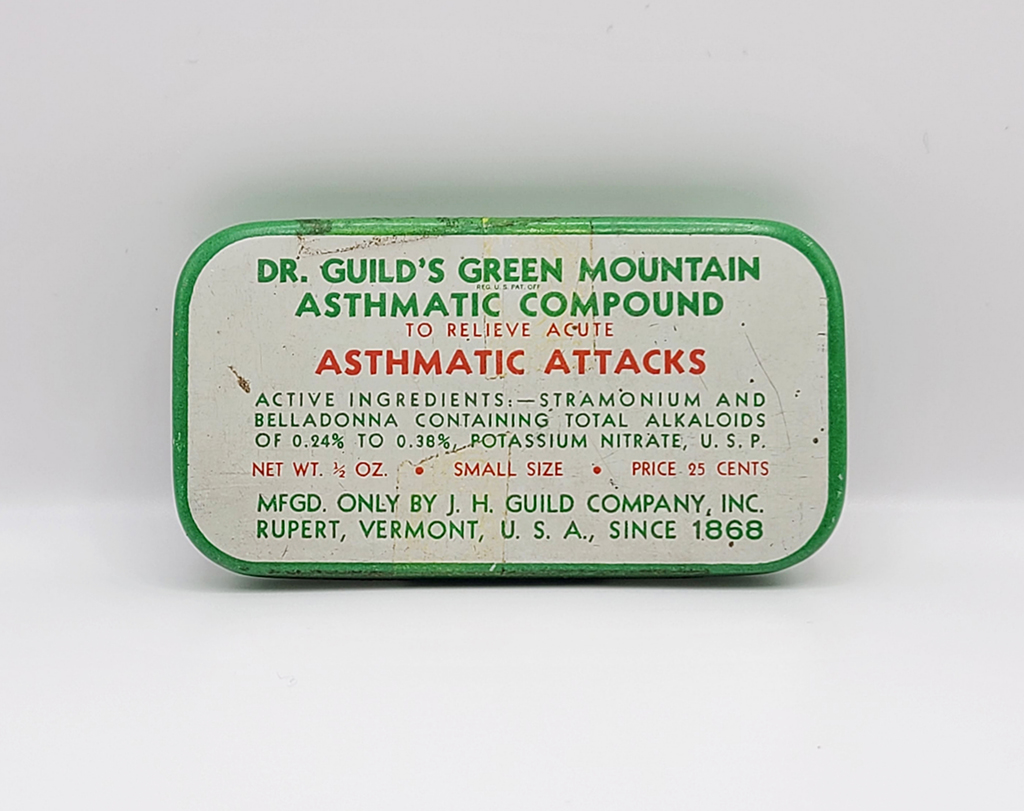
This asthmatic medicine was designed to work through inhalation. The user would light a spoonful of the substance and inhale the fumes to relieve symptoms of an asthma attack. Also available in cigarette form, this medicine includes toxic ingredients like belladonna and stramonium.
Homeopathic and Herbal Medicine
Homeopathic and herbal medicine are prominent components of alternative healthcare. Alternative medicine emphasizes stimulating the body's innate healing abilities through energy alignment, herbal supplements, and various balancing techniques. The effectiveness of these treatments has sparked ongoing debates due to challenges related to testability, repeatability, and a lack of substantial evidence.
However, it's essential to note that many individuals continue to seek and incorporate these therapies into their healthcare regimens, often in conjunction with conventional medicine. This enduring interest highlights the complex and evolving landscape of healthcare choices available to people today.
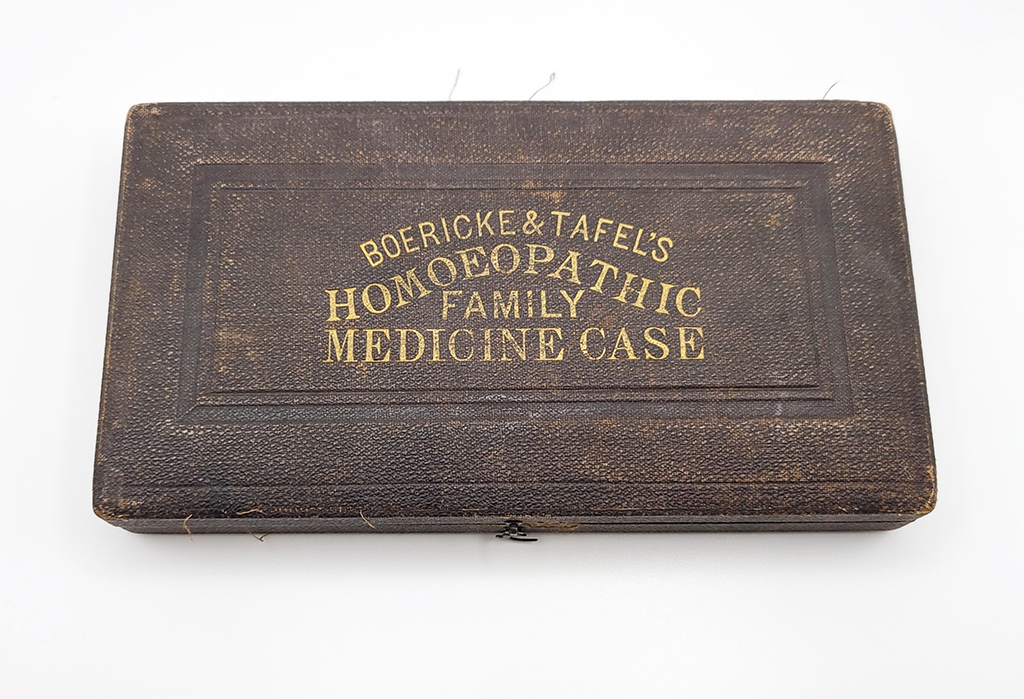
This handy kit of homeopathic concoctions was created by Boericke & Tafel’s Homeopathic Pharmacy. The kit contains 17 homeopathic remedies (the 18th is missing) along with instructions for their use. Homeopathic medicine became very popular in the 19th century as many viewed traditional medicine practices as harmful and ineffective. By the end of the 19th century, Boericke & Tafel were the largest manufacturer of homeopathic medicines in the United States.
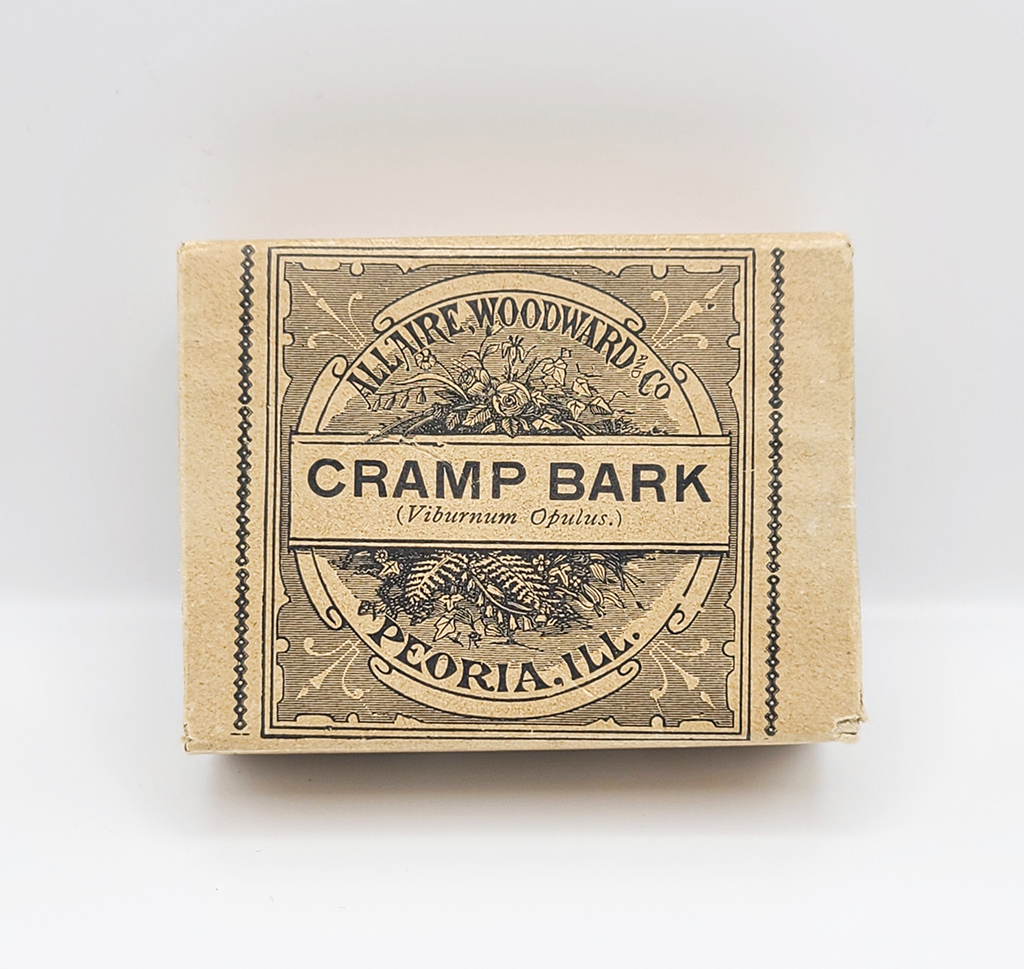
As the name suggests, this plant is used to relieve cramps from muscle spasms, menstrual cramps, and pregnancy cramps. It is also used as a kidney stimulant and for reducing swollen glands.
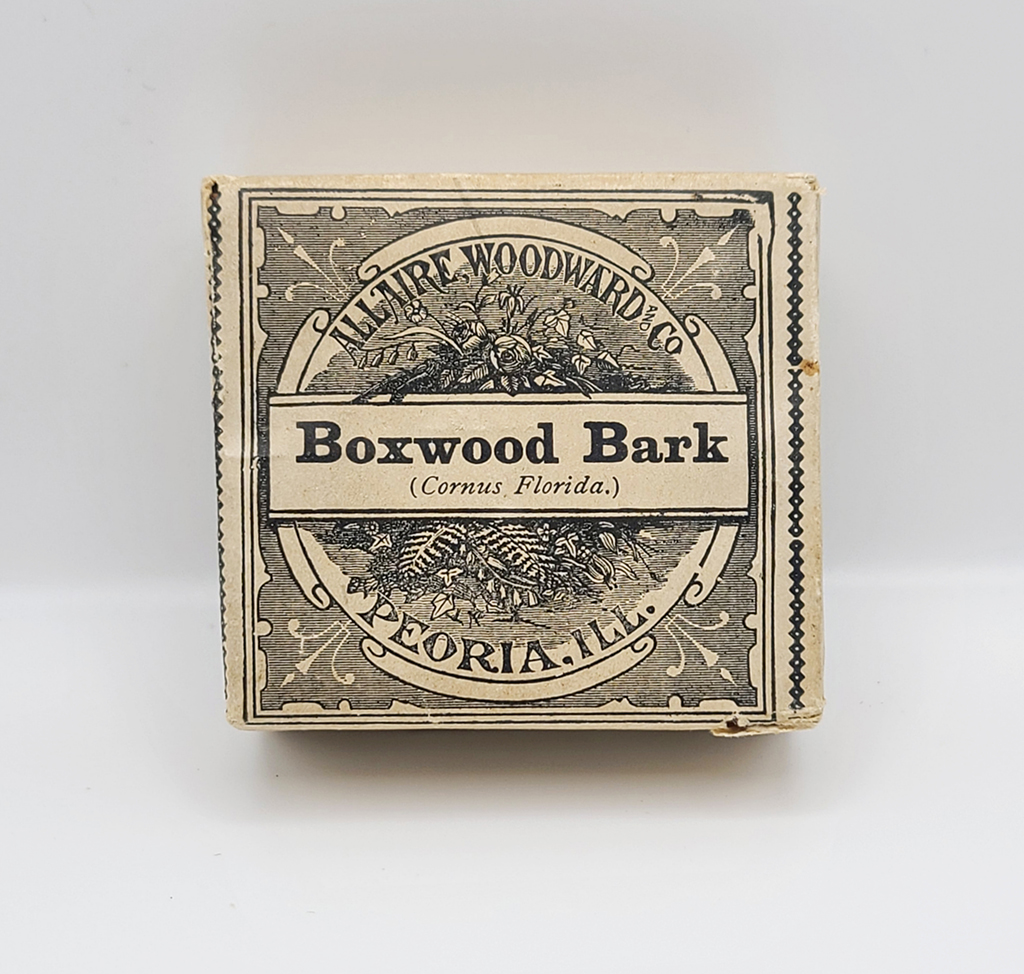
Otherwise known as flowering dogwood, this plant was used to treat colic pains, headaches and backaches, sore throat, muscle inflammation, and malaria.
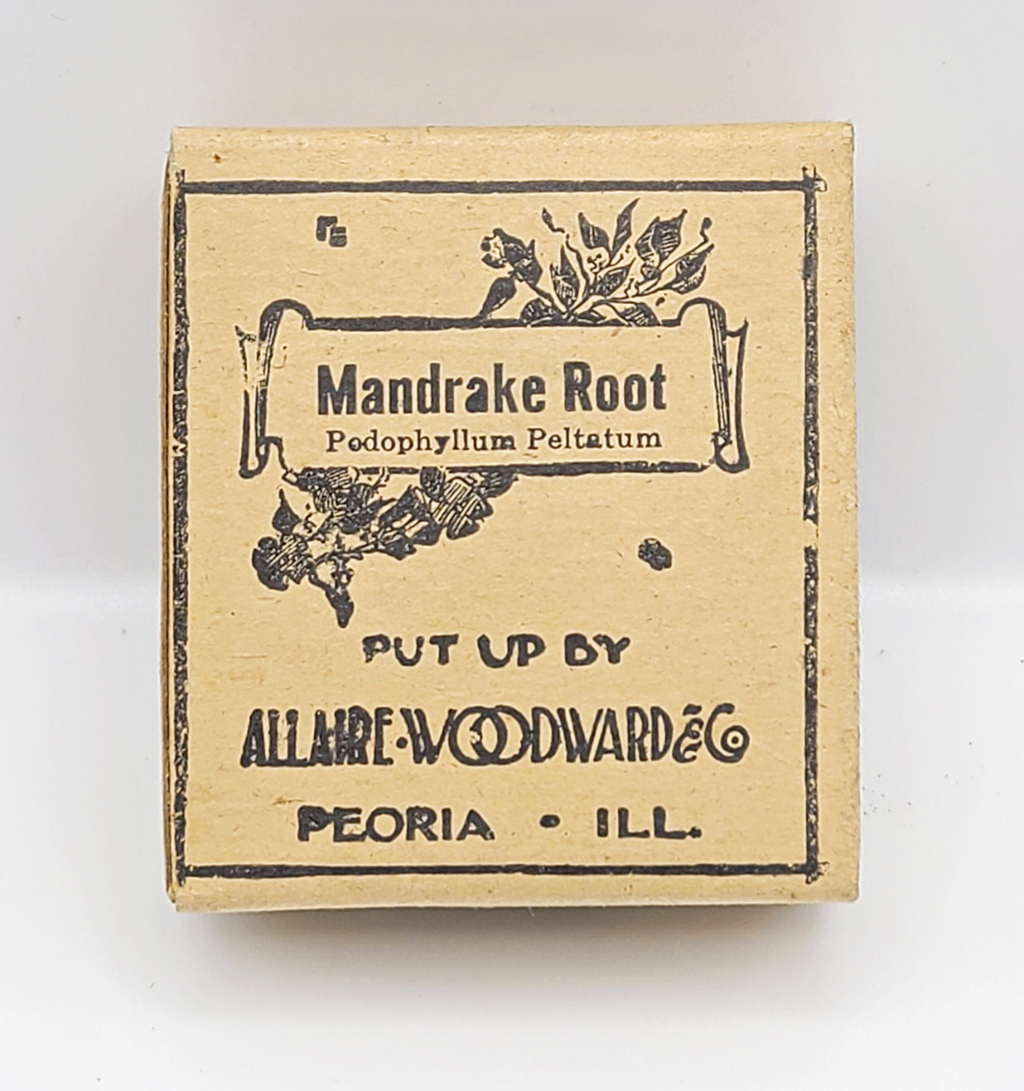
The mandrake is an herb that is native to the Mediterranean region. The root of the mandrake, which has been popularized in media and folklore, is used to treat colic, constipation, whopping cough, pain, and hay fever.
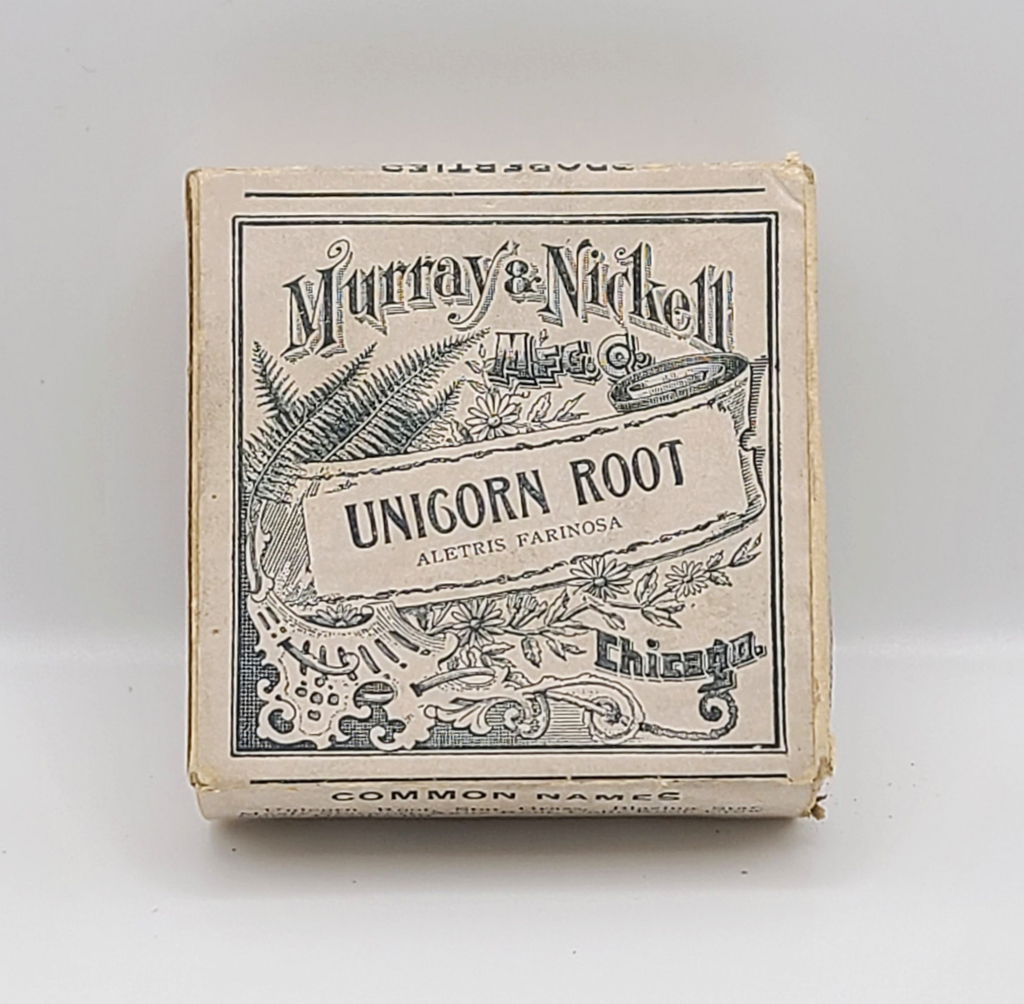
Aletris farinosa, more commonly called the unicorn root, is a flowering herb shrub that grows in the eastern United States. It has been used to relieve menstrual, joint, and muscle pain and as an infertility agent.
